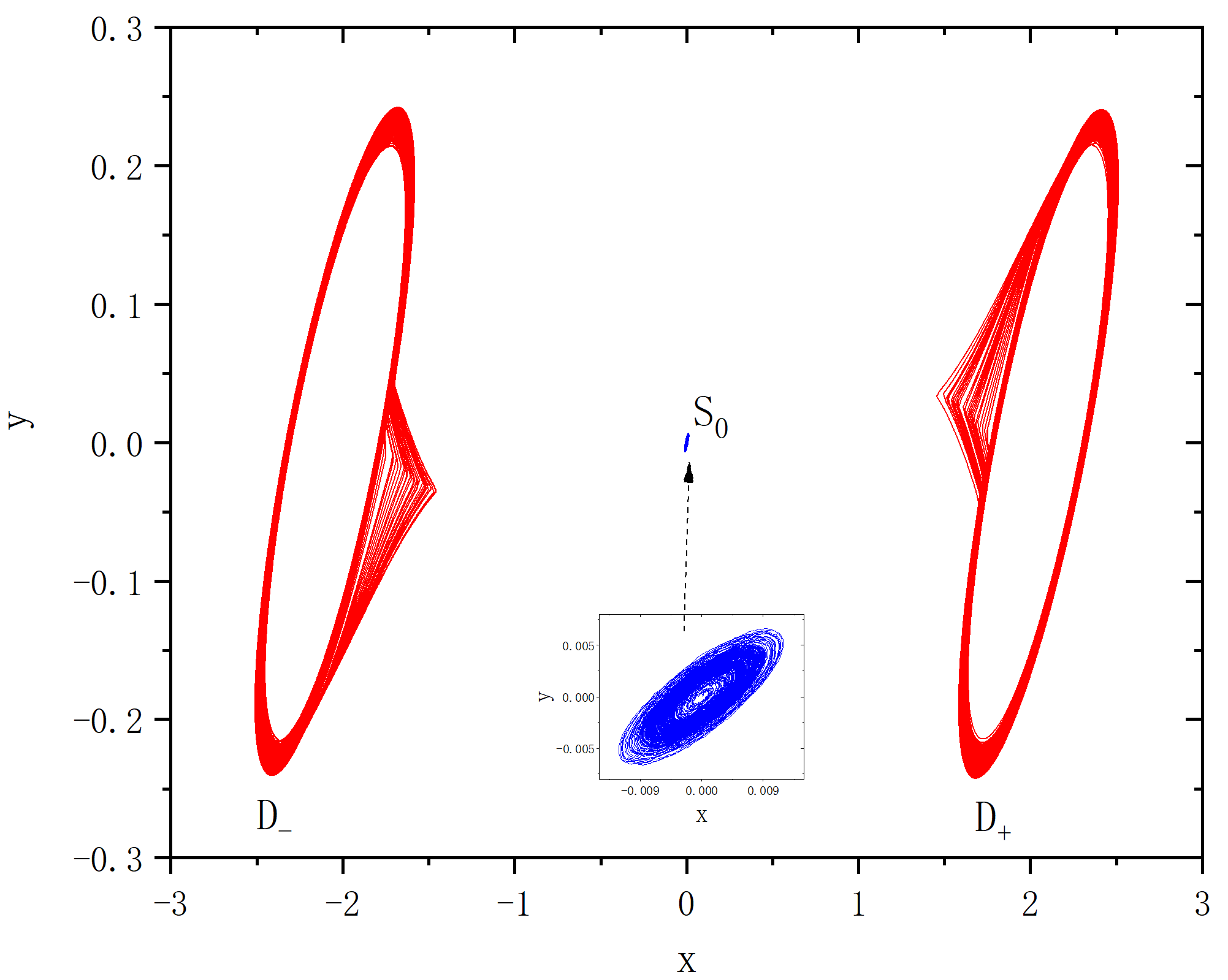Emergence of chimeras through induced multistability
阅读
下载地址:
2018_PRE_Emergence of chimeras through induced multistability.pdf
复现
figure 1
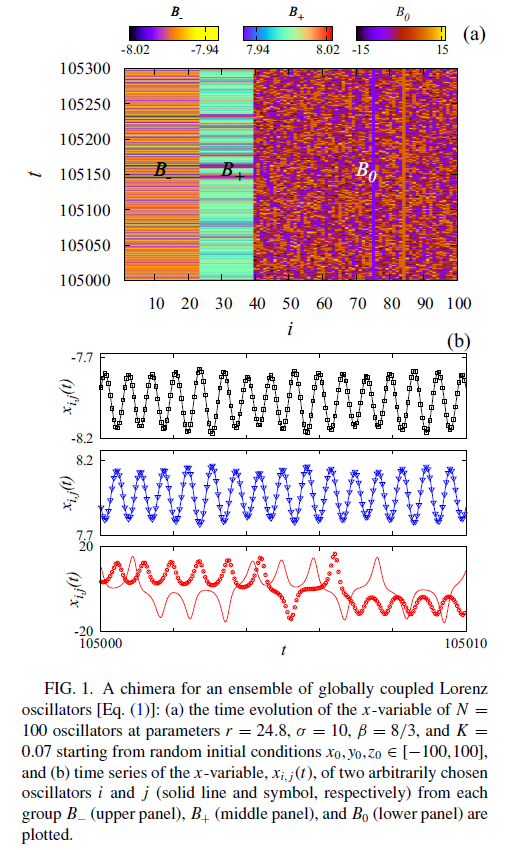
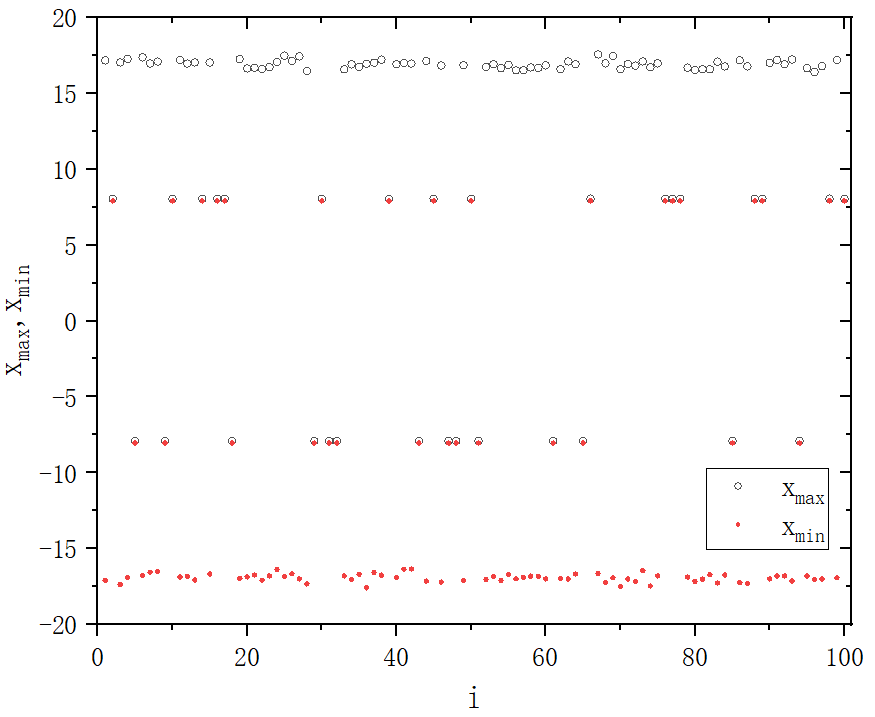
module Lorenz
implicit none
real,parameter :: h=0.01
integer,parameter :: MaxT=10530000,T_trans=10500000,N=3,M=100
real :: x(M,N)
integer,allocatable :: neighbour_matrix(:,:)
contains
subroutine x0()
implicit none
integer :: i
real :: x1,x2,x3
call random_seed()
open(5,file="x0_y0_z0.txt")
do i=1,M,1
!call random_number(x1)
!call random_number(x2)
!call random_number(x3)
!x(i,1)=x1*100.0-100.0
!x(i,2)=x2*100.0-100.0
!x(i,3)=x3*100.0-100.0
read(5,*) x(i,1),x(i,2),x(i,3)
end do
close(5)
end subroutine x0
subroutine fnf(xx,fx,i)
implicit none
real :: xx(N),fx(N),coupling
integer :: t,i,j
real :: a,b,c,K
a=10.0 !sigma
b=8.0/3.0 !beta
c=24.8 !r
K=0.07
coupling=0.0
do j=1,M,1
coupling=coupling+neighbour_matrix(i,j)*(x(j,3)-x(i,3))
end do
fx(1)=a*(xx(2)-xx(1))
fx(2)=c*xx(1)-xx(2)-xx(1)*xx(3)
fx(3)=xx(1)*xx(2)-b*xx(3)+(K/real(M-1))*coupling
return
end subroutine fnf
subroutine rk4(x)
implicit none
integer :: i
real :: x(M,N),xx(N),fx(N)
real :: kx1(N),kx2(N),kx3(N),kx4(N)
do i=1,M,1
xx=x(i,:)
call fnf(xx,fx,i)
kx1=h*fx
xx=x(i,:)+0.5*kx1
call fnf(xx,fx,i)
kx2=h*fx
xx=x(i,:)+0.5*kx2
call fnf(xx,fx,i)
kx3=h*fx
xx=x(i,:)+kx3
call fnf(xx,fx,i)
kx4=h*fx
x(i,:)=x(i,:)+(kx1+2.0*kx2+2.0*kx3+kx4)/6.0
end do
return
end subroutine rk4
!Umax与Umin
subroutine U_max_min(xxx,U_max,U_min)
implicit none
real :: U_max(M),U_min(M),xxx(M)
integer :: i
do i=1,M,1
if(U_max(i)<xxx(i)) then
U_max(i)=xxx(i)
end if
if(U_min(i)>xxx(i)) then
U_min(i)=xxx(i)
end if
end do
return
end subroutine U_max_min
!建立网络结构
subroutine neighbour(K)
implicit none
integer :: K !单节点K个邻居
integer :: i,j,number
allocate(neighbour_matrix(M,M))
!初始化网络矩阵
neighbour_matrix=0
do i=1,M-1,1
do j=i+1,M,1
neighbour_matrix(i,j)=1
neighbour_matrix(j,i)=1
end do
end do
!输出矩阵
do i=1,M,1
do j=1,M,1
write(10,"(I2)",advance='no') neighbour_matrix(i,j)
end do
write(10,*)
end do
return
end subroutine neighbour
end module Lorenz
program main
use Lorenz
implicit none
integer :: t,i,j,p=1,counter
real :: U_max(M),U_min(M),data(M,MaxT-T_trans,3)
open(10,file="neighbour_matrix.txt")
open(20,file="i_t_x_B-.txt")
open(21,file="i_t_x_B+.txt")
open(22,file="i_t_x_B0.txt")
open(30,file="xmax_xmin.txt")
open(40,file="t_x_1.txt")
open(41,file="t_x_5.txt")
open(42,file="t_x_50.txt")
open(43,file="t_x_23.txt")
open(44,file="t_x_95.txt")
open(45,file="t_x_36.txt")
open(46,file="t_x_61.txt")
open(50,file="t_x_1_data.txt")
open(60,file="error.txt")
call neighbour(2*p)
call x0
U_max=-1000.0
U_min=1000.0
counter=1
do t=1,MaxT,1
call rk4(x)
if(t>T_trans) then
call U_max_min(x(:,1),U_max,U_min)
write(40,*) (t-T_trans)*h,x(1,1),x(1,2),x(1,3)
write(41,*) (t-T_trans)*h,x(5,1),x(5,2),x(5,3)
write(42,*) (t-T_trans)*h,x(50,1),x(50,2),x(50,3)
write(43,*) (t-T_trans)*h,x(23,1),x(23,2),x(23,3)
write(44,*) (t-T_trans)*h,x(95,1),x(95,2),x(95,3)
write(45,*) (t-T_trans)*h,x(36,1),x(36,2),x(36,3)
write(46,*) (t-T_trans)*h,x(61,1),x(61,2),x(61,3)
!将相同的动力学模式放在一起
do i=1,M,1
data(i,t-T_trans,1) = x(i,1)
data(i,t-T_trans,2) = x(i,2)
data(i,t-T_trans,3) = x(i,3)
end do
end if
end do
do i=1,M,1
write(30,*) i,U_max(i),U_min(i)
do t=1,MaxT-T_trans,1
if(abs(U_max(i))-abs(U_min(i))<5.0.and.U_max(i)<0) then
!B-
if(mod(t,100)==0) then
write(20,*) i,t,data(i,t,1),data(i,t,2),data(i,t,3)
end if
else if(abs(U_max(i))-abs(U_min(i))<5.0.and.U_min(i)>0) then
!B+
if(mod(t,100)==0) then
write(21,*) i,t,data(i,t,1),data(i,t,2),data(i,t,3)
end if
else if(U_max(i)-U_min(i)>5.0.and.U_min(i)<0.and.U_max(i)>0) then
!B0
if(mod(t,100)==0) then
write(22,*) i,t,data(i,t,1),data(i,t,2),data(i,t,3)
end if
else
write(60,*) "条件有误!"
end if
end do
end do
close(10)
close(20)
close(30)
close(40)
deallocate(neighbour_matrix)
end program mainfigure 1_A
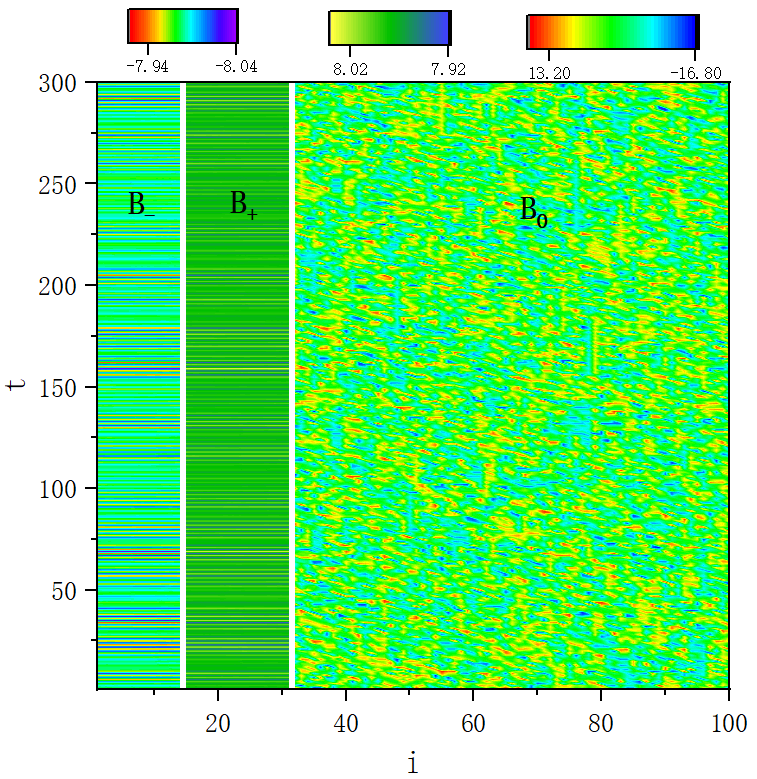
figure 1_B
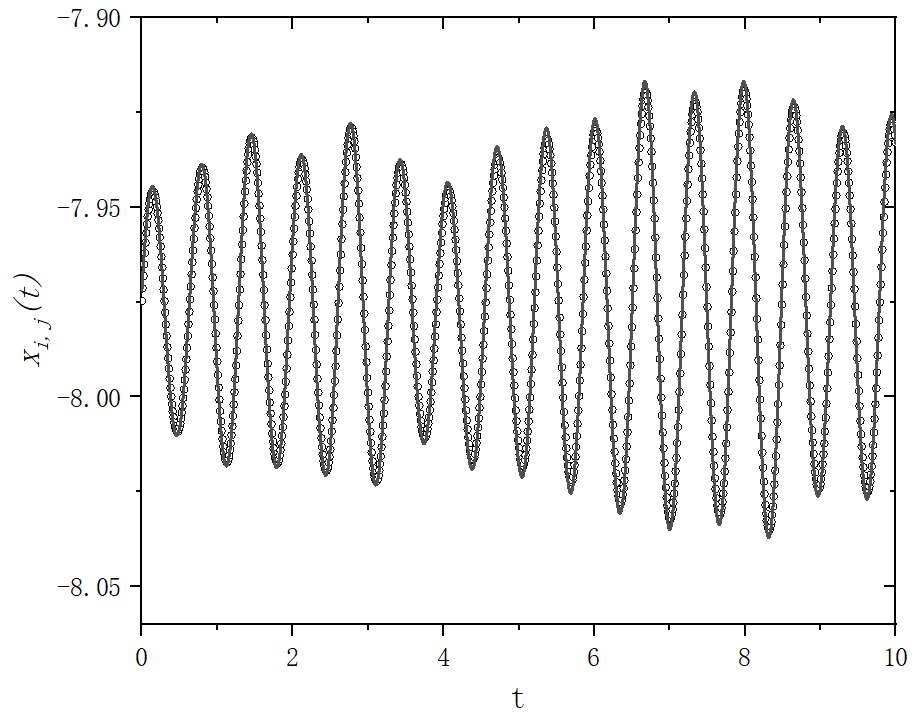
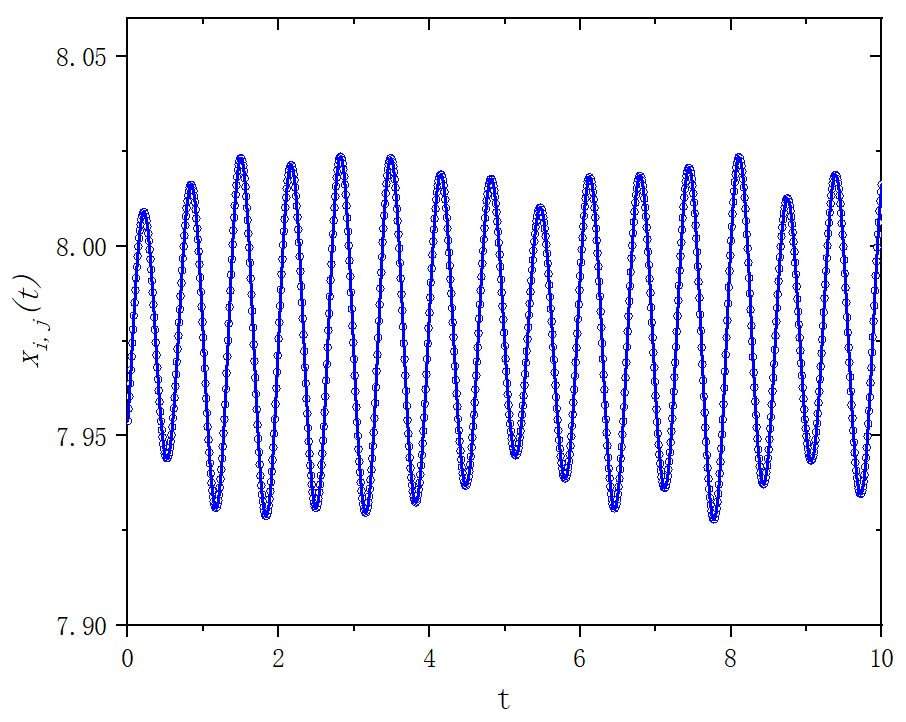
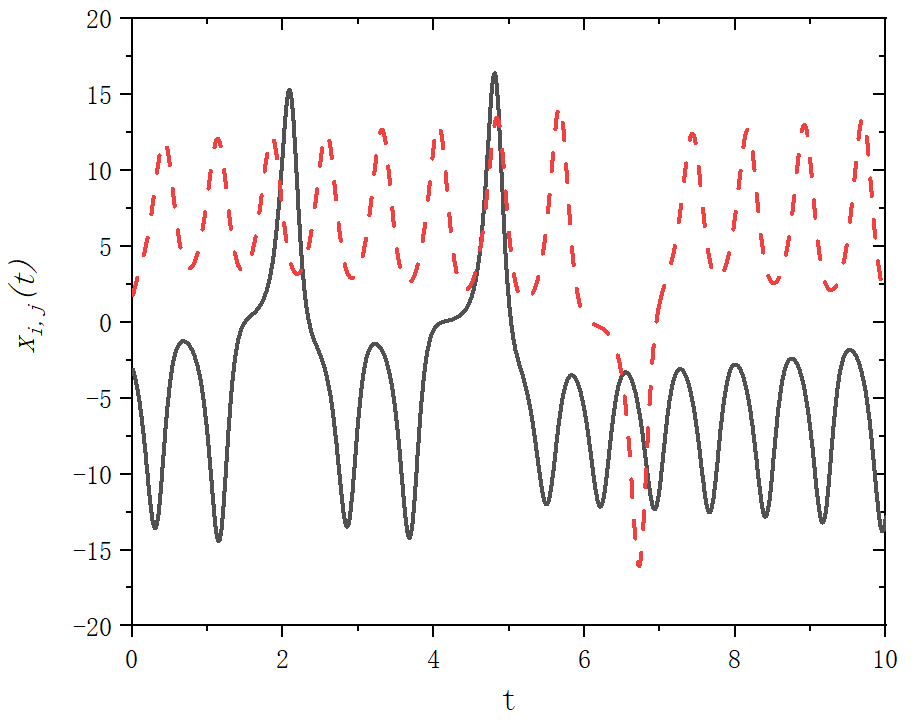
figure 2
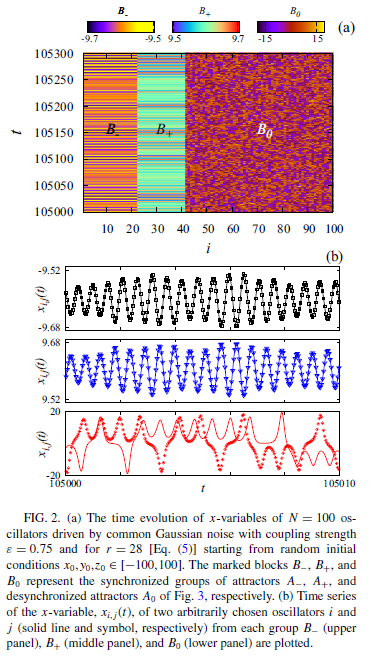

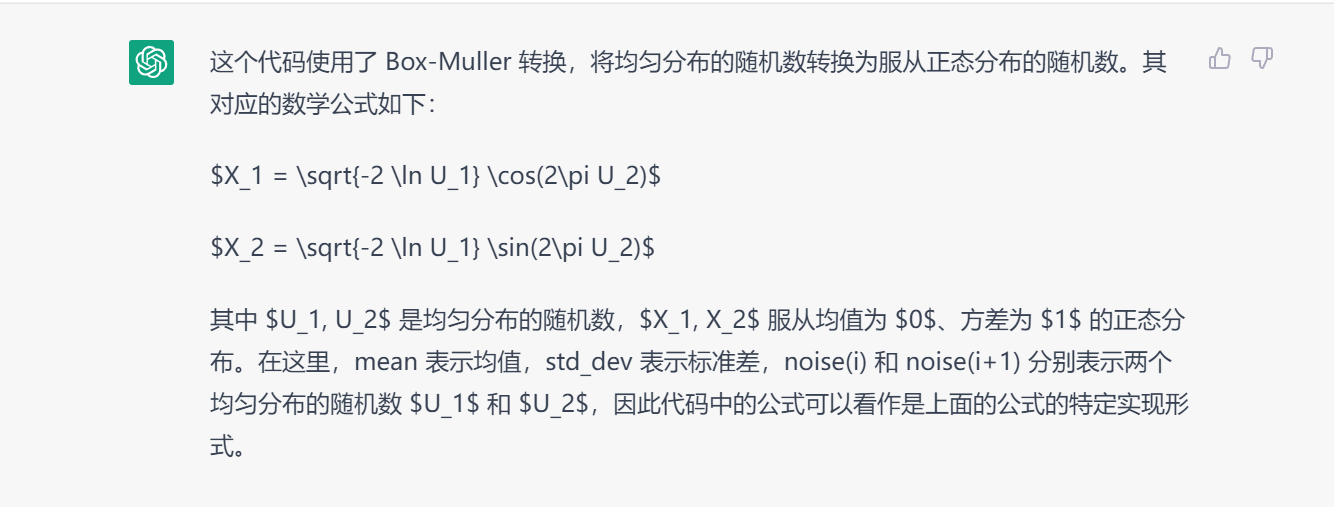
module Lorenz
implicit none
real,parameter :: h=0.01
integer,parameter :: MaxT=180000,T_trans=150000,N=3,M=100
real :: x(M,N),f(MaxT)
integer,allocatable :: neighbour_matrix(:,:)
contains
subroutine x0()
implicit none
integer :: i
real :: x1,x2,x3
call random_seed()
open(5,file="x0_y0_z0.txt")
do i=1,M,1
!call random_number(x1)
!call random_number(x2)
!call random_number(x3)
!x(i,1)=x1*100.0-100.0
!x(i,2)=x2*100.0-100.0
!x(i,3)=x3*100.0-100.0
read(5,*) x(i,1),x(i,2),x(i,3)
end do
close(5)
end subroutine x0
subroutine fnf(xx,fx,i,t)
implicit none
real :: xx(N),fx(N)
integer :: t,i,j
real :: a,b,c,K,epsilon
a=10.0 !sigma
b=8.0/3.0 !beta
c=28.0 !r
epsilon=0.75
fx(1)=a*(xx(2)-xx(1))
fx(2)=c*xx(1)-xx(2)-xx(1)*xx(3)
fx(3)=xx(1)*xx(2)-b*xx(3)+epsilon*(f(t)-xx(3))
return
end subroutine fnf
subroutine rk4(x,t)
implicit none
integer :: i,t
real :: x(M,N),xx(N),fx(N)
real :: kx1(N),kx2(N),kx3(N),kx4(N)
do i=1,M,1
xx=x(i,:)
call fnf(xx,fx,i,t)
kx1=h*fx
xx=x(i,:)+0.5*kx1
call fnf(xx,fx,i,t)
kx2=h*fx
xx=x(i,:)+0.5*kx2
call fnf(xx,fx,i,t)
kx3=h*fx
xx=x(i,:)+kx3
call fnf(xx,fx,i,t)
kx4=h*fx
x(i,:)=x(i,:)+(kx1+2.0*kx2+2.0*kx3+kx4)/6.0
end do
return
end subroutine rk4
!Umax与Umin
subroutine U_max_min(xxx,U_max,U_min)
implicit none
real :: U_max(M),U_min(M),xxx(M)
integer :: i
do i=1,M,1
if(U_max(i)<xxx(i)) then
U_max(i)=xxx(i)
end if
if(U_min(i)>xxx(i)) then
U_min(i)=xxx(i)
end if
end do
return
end subroutine U_max_min
!建立网络结构
subroutine neighbour()
implicit none
integer :: K !单节点K个邻居
integer :: i,j,number
allocate(neighbour_matrix(M,M))
!初始化网络矩阵
neighbour_matrix=0
do i=1,M-1,1
do j=i+1,M,1
neighbour_matrix(i,j)=1
neighbour_matrix(j,i)=1
end do
end do
!输出矩阵
do i=1,M,1
do j=1,M,1
write(10,"(I2)",advance='no') neighbour_matrix(i,j)
end do
write(10,*)
end do
return
end subroutine neighbour
!普通高斯白噪声
subroutine gaussNoise()
implicit none
integer, parameter :: L = MaxT ! 生成噪声的长度
real,parameter :: pi=3.1415926
real :: noise(L) ! 储存噪声的数组
real :: mean = 0.0 ! 均值
real :: std_dev = 1.0 ! 标准差
integer :: seed = 1 ! 随机数种子
integer :: i
open(11,file="noise.txt")
! 生成噪声
call random_seed()
do i = 1, L
call random_number(noise(i))
end do
do i=1,L-1
noise(i) = mean + std_dev * sqrt(-2.0 * log(noise(i))) * cos(2.0 * pi * noise(i + 1))
end do
noise(L)=0.0
! 输出噪声
do i = 1, L
f(i)=noise(i)
!write(11,*) i,noise(i)
end do
return
end subroutine gaussNoise
end module Lorenz
program main
use Lorenz
implicit none
integer :: t,i,j
real :: U_max(M),U_min(M),data(M,MaxT-T_trans,3)
open(10,file="neighbour_matrix.txt")
open(20,file="i_t_x_B-.txt")
open(21,file="i_t_x_B+.txt")
open(22,file="i_t_x_B0.txt")
open(30,file="xmax_xmin.txt")
open(40,file="t_x_1.txt")
open(41,file="t_x_4.txt")
open(42,file="t_x_8.txt")
open(43,file="t_x_17.txt")
open(44,file="t_x_29.txt")
open(45,file="t_x_20.txt")
open(46,file="t_x_26.txt")
open(50,file="t_x_1_data.txt")
call neighbour()
call x0
call gaussNoise()
U_max=-1000.0
U_min=1000.0
do t=1,MaxT,1
call rk4(x,t)
if(t>T_trans) then
call U_max_min(x(:,1),U_max,U_min)
write(40,*) (t-T_trans)*h,x(1,1),x(1,2),x(1,3)
write(41,*) (t-T_trans)*h,x(4,1),x(4,2),x(4,3)
write(42,*) (t-T_trans)*h,x(8,1),x(8,2),x(8,3)
write(43,*) (t-T_trans)*h,x(17,1),x(17,2),x(17,3)
write(44,*) (t-T_trans)*h,x(29,1),x(29,2),x(29,3)
write(45,*) (t-T_trans)*h,x(20,1),x(20,2),x(20,3)
write(46,*) (t-T_trans)*h,x(26,1),x(26,2),x(26,3)
!将相同的动力学模式放在一起
do i=1,M,1
data(i,t-T_trans,1) = x(i,1)
data(i,t-T_trans,2) = x(i,2)
data(i,t-T_trans,3) = x(i,3)
end do
end if
end do
do i=1,M,1
write(30,*) i,U_max(i),U_min(i)
do t=1,MaxT-T_trans,1
if(abs(U_max(i))-abs(U_min(i))<5.0.and.U_max(i)<0) then
!B-
if(mod(t,100)==0) then
write(20,*) i,t,data(i,t,1),data(i,t,2),data(i,t,3)
end if
else if(abs(U_max(i))-abs(U_min(i))<5.0.and.U_min(i)>0) then
!B+
if(mod(t,100)==0) then
write(21,*) i,t,data(i,t,1),data(i,t,2),data(i,t,3)
end if
else if(U_max(i)-U_min(i)>5.0.and.U_min(i)<0.and.U_max(i)>0) then
!B0
if(mod(t,100)==0) then
write(22,*) i,t,data(i,t,1),data(i,t,2),data(i,t,3)
end if
else
write(60,*) "条件有误!"
end if
end do
end do
close(10)
close(20)
close(30)
close(40)
deallocate(neighbour_matrix)
end program mainfigure 2_A
module Tools
implicit none
integer :: Rows
real,allocatable :: c_peak_interval(:,:)
contains
!确定文件行数
subroutine read_file()
implicit none
integer :: count,iostat,number,i,j
real :: x1,x2,x3,x4,x5
character(len=100) :: line ! 用于存储每行数据
! 打开文件
open(unit=5, file='i_t_x_B0.txt', status='old', action='read')
! 逐行读取文件并计算行数
count = 0
number= 300
do
read(5, '(A)', iostat=iostat) line
if (iostat /= 0) exit ! 如果读取到文件末尾,则退出循环
count = count + 1
end do
Rows=count
close(5)
open(unit=5, file='i_t_x_B0.txt', status='old', action='read')
do i=1,Rows/number,1
do j=1,number,1
read(5,*) x1,x2,x3,x4,x5
write(10,*) i,x2,x3,x4,x5
end do
end do
end subroutine read_file
end module Tools
program main
use Tools
implicit none
open(10,file="i_t_x_B0_modify.txt")
call read_file
return
end program main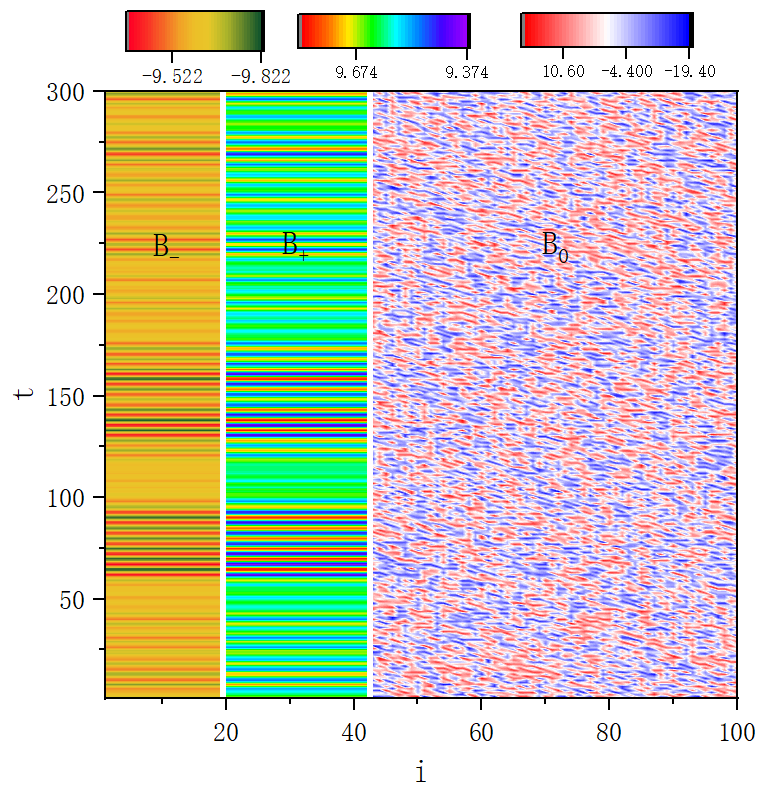
figure 2_B
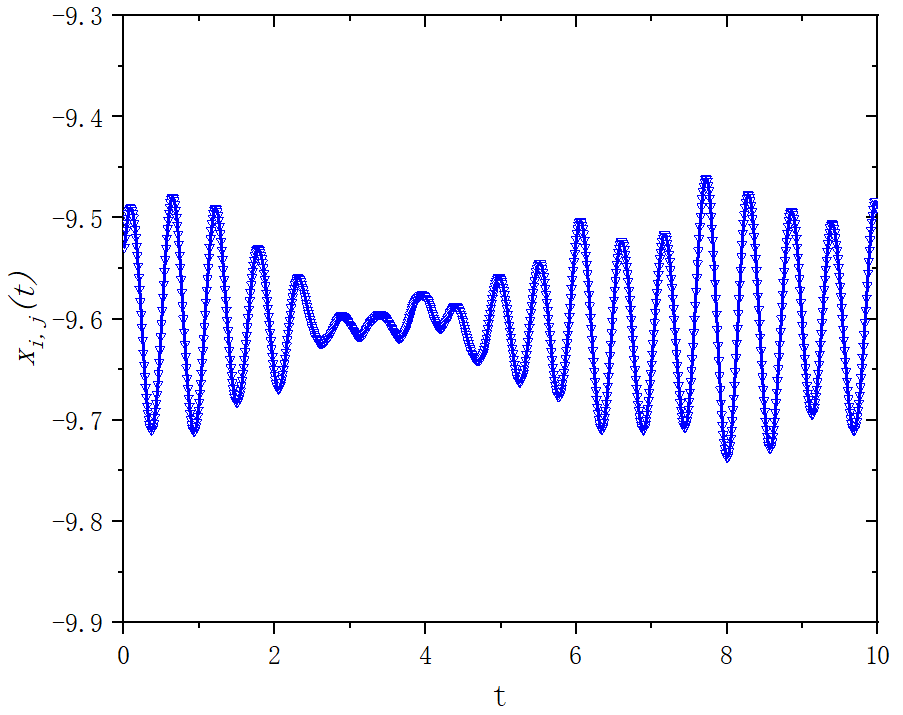
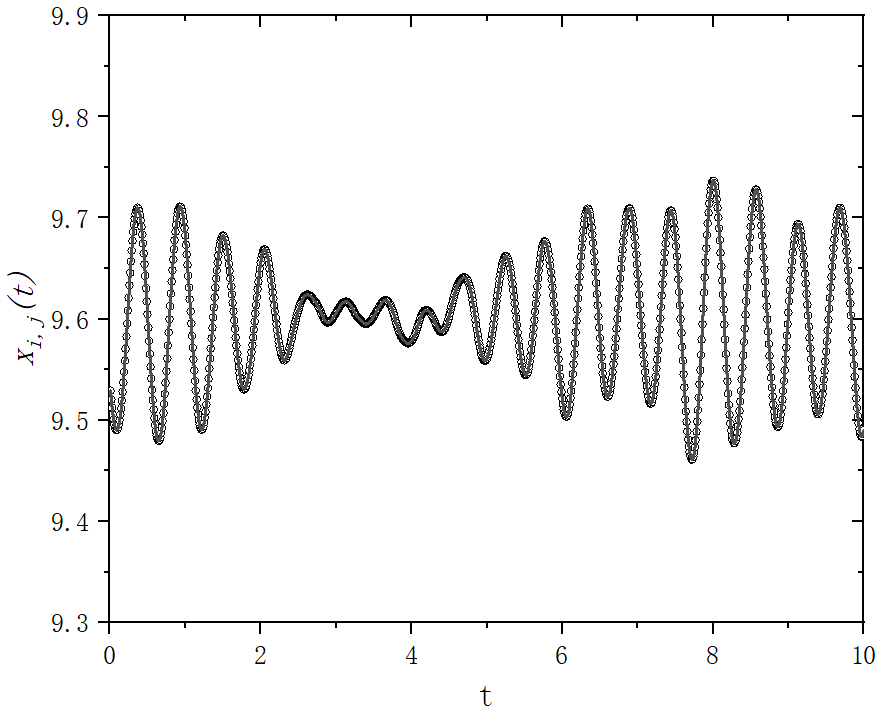
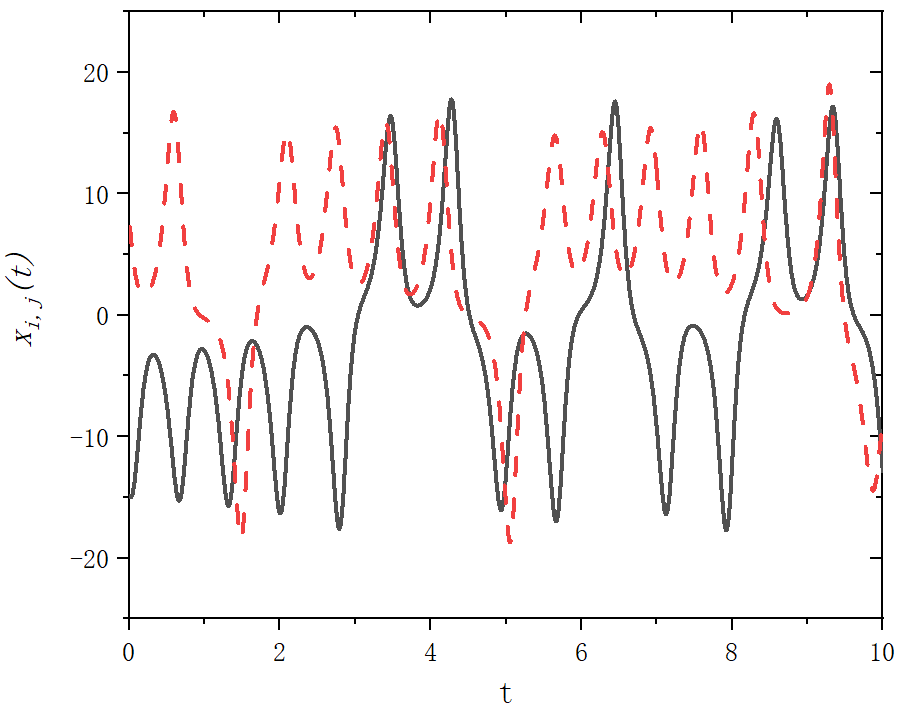
figure 3
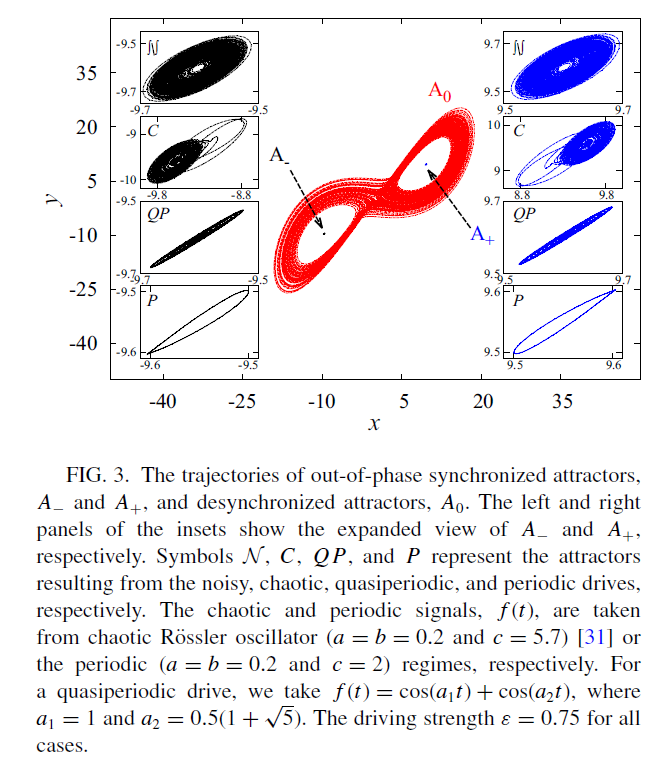
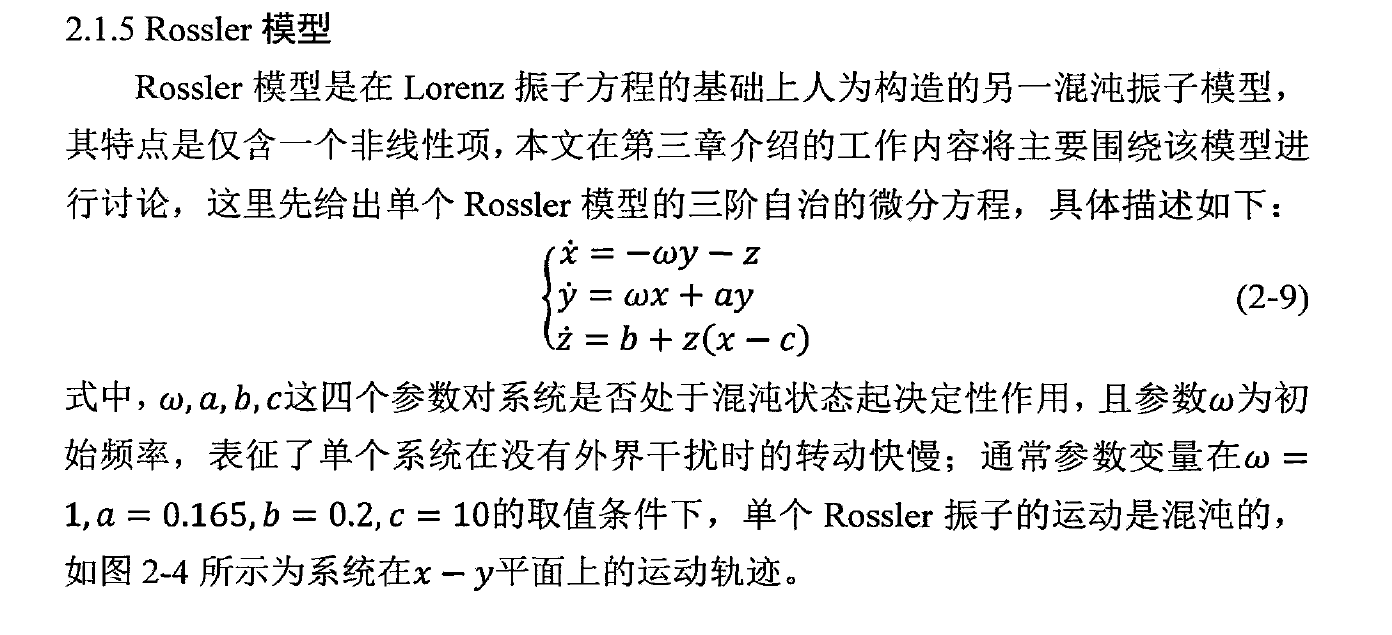
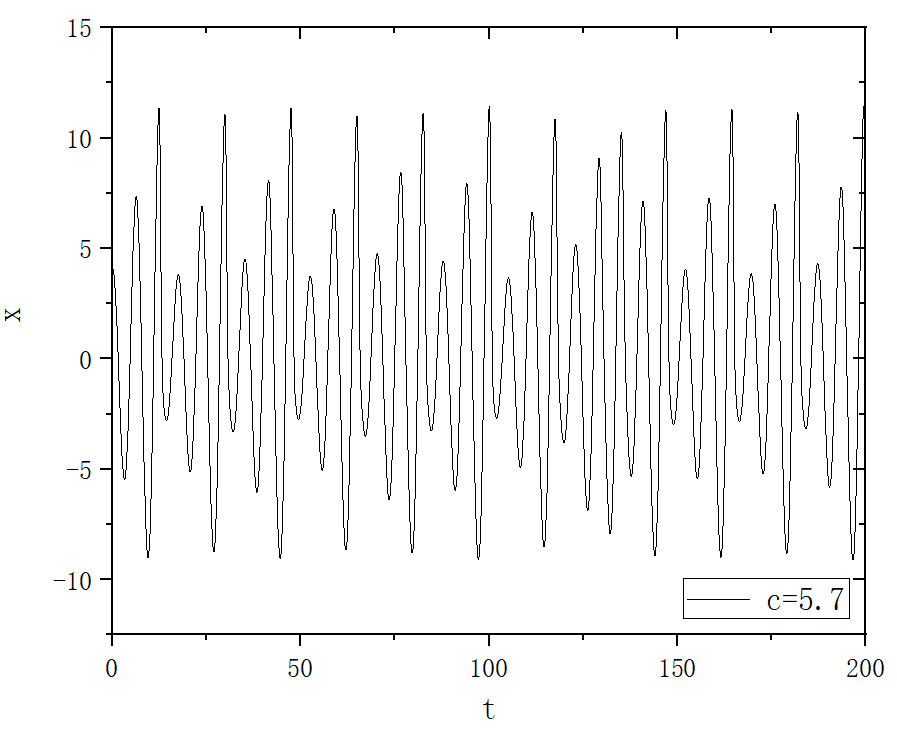
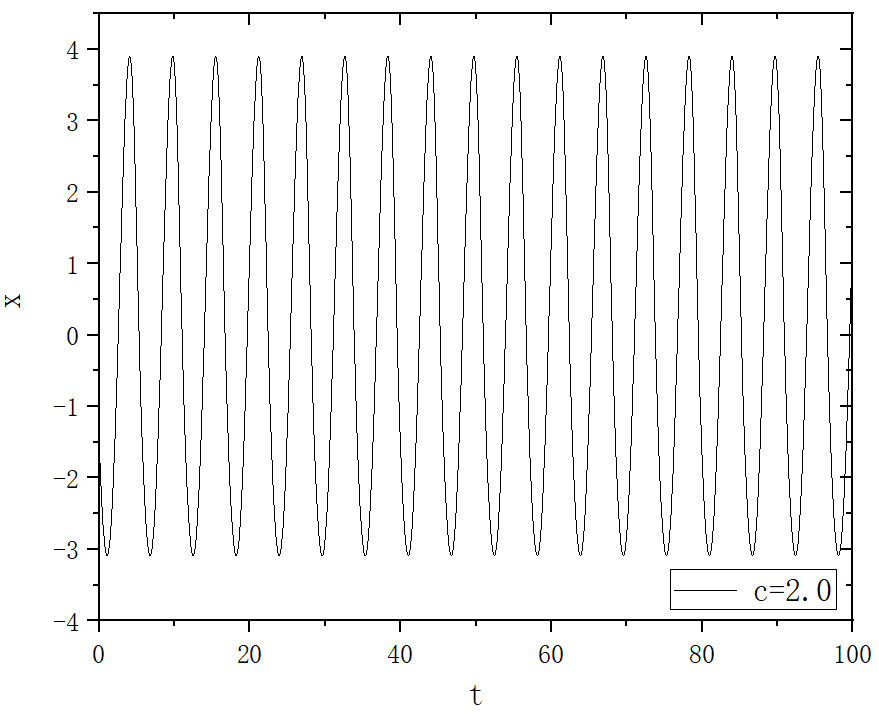
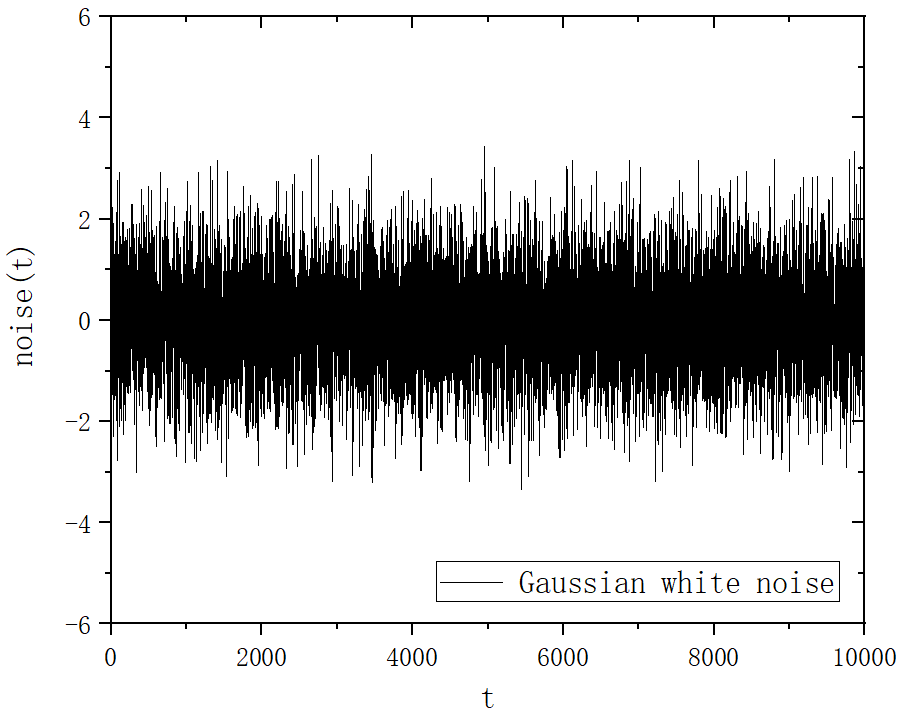
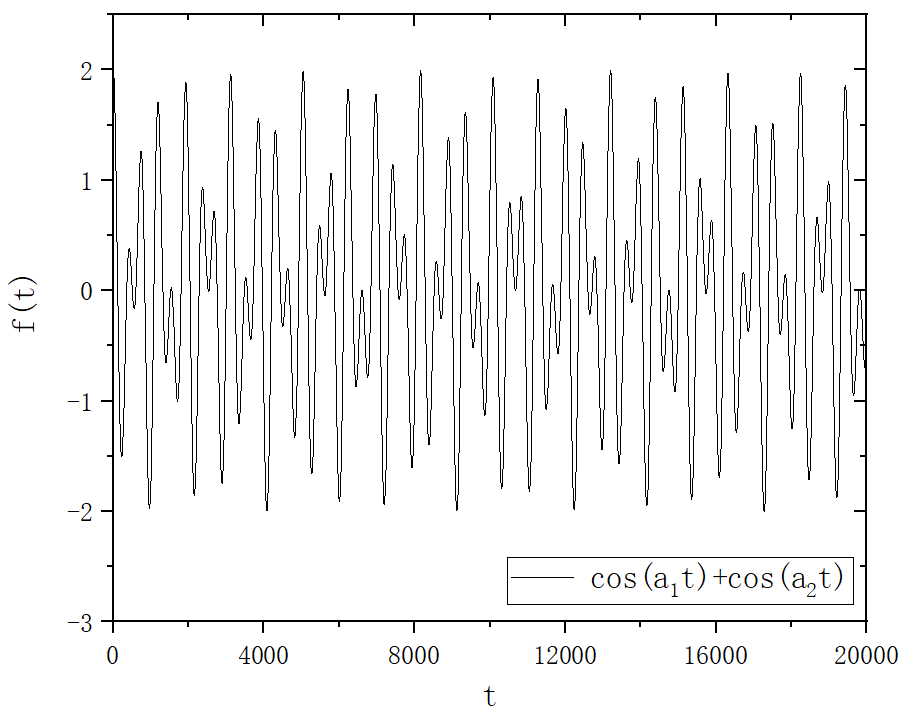
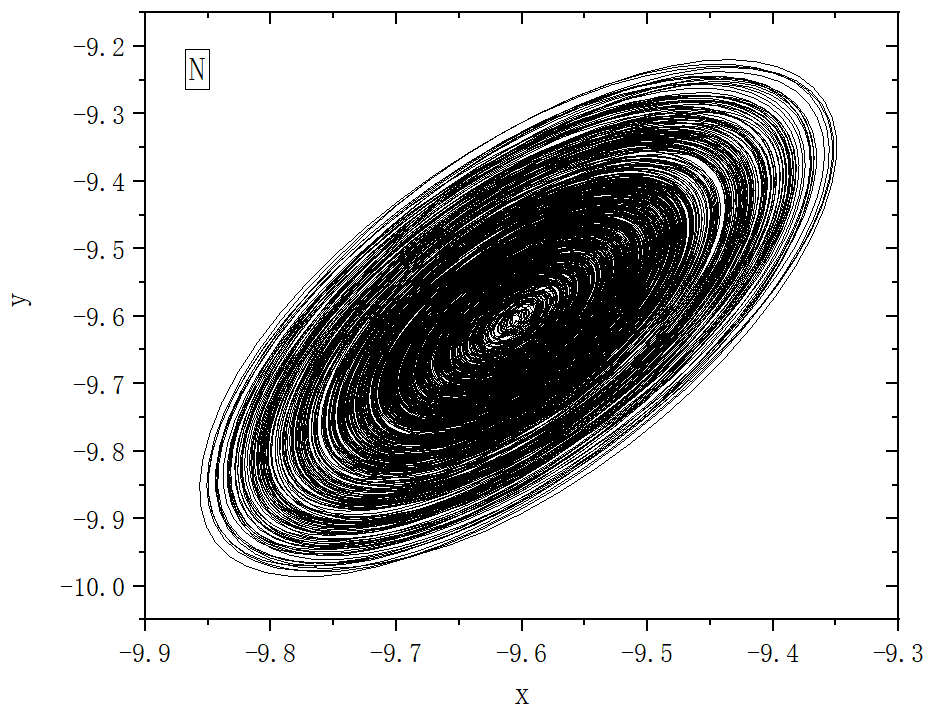
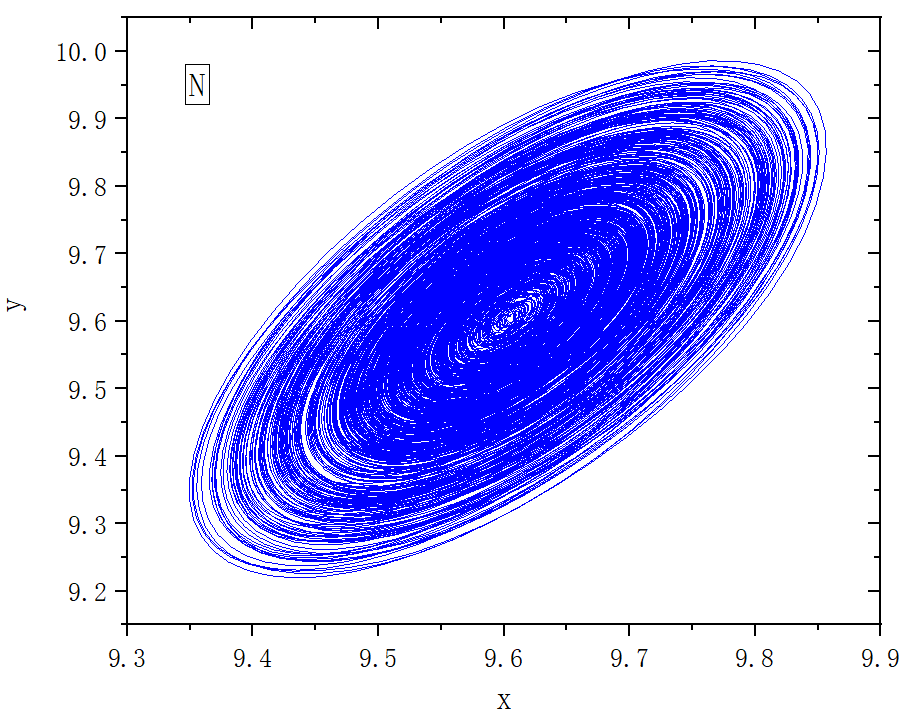
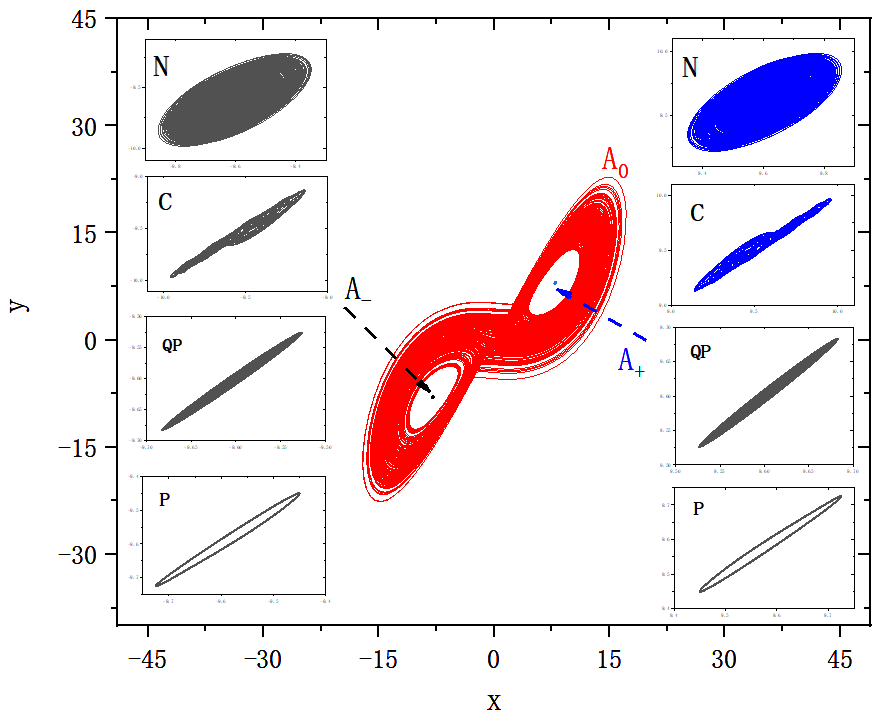
figure 4
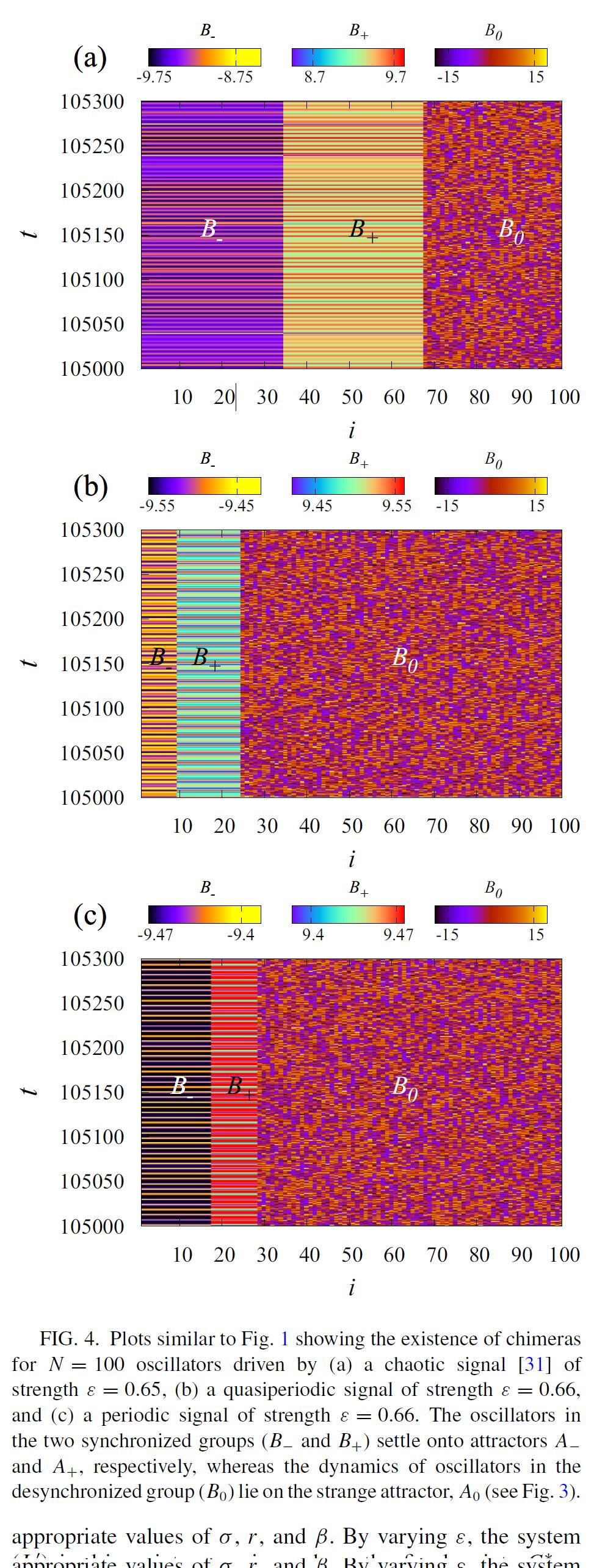
module Lorenz
implicit none
real,parameter :: h=0.01
integer,parameter :: MaxT=10530000,T_trans=10500000,N=3,M=100
real :: x(M,N),f(MaxT)
integer,allocatable :: neighbour_matrix(:,:)
contains
subroutine x0()
implicit none
integer :: i
real :: x1,x2,x3
call random_seed()
open(5,file="x0_y0_z0.txt")
do i=1,M,1
call random_number(x1)
call random_number(x2)
call random_number(x3)
x(i,1)=x1*100.0-100.0
x(i,2)=x2*100.0-100.0
x(i,3)=x3*100.0-100.0
write(5,*) x(i,1),x(i,2),x(i,3)
end do
close(5)
end subroutine x0
subroutine fnf(xx,fx,i,t)
implicit none
real :: xx(N),fx(N)
integer :: t,i,j
real :: a,b,c,K,epsilon
a=10.0 !sigma
b=8.0/3.0 !beta
c=28.0 !r
epsilon=0.65
fx(1)=a*(xx(2)-xx(1))
fx(2)=c*xx(1)-xx(2)-xx(1)*xx(3)
fx(3)=xx(1)*xx(2)-b*xx(3)+epsilon*(f(t)-xx(3))
return
end subroutine fnf
subroutine rk4(x,t)
implicit none
integer :: i,t
real :: x(M,N),xx(N),fx(N)
real :: kx1(N),kx2(N),kx3(N),kx4(N)
do i=1,M,1
xx=x(i,:)
call fnf(xx,fx,i,t)
kx1=h*fx
xx=x(i,:)+0.5*kx1
call fnf(xx,fx,i,t)
kx2=h*fx
xx=x(i,:)+0.5*kx2
call fnf(xx,fx,i,t)
kx3=h*fx
xx=x(i,:)+kx3
call fnf(xx,fx,i,t)
kx4=h*fx
x(i,:)=x(i,:)+(kx1+2.0*kx2+2.0*kx3+kx4)/6.0
end do
return
end subroutine rk4
!Umax与Umin
subroutine U_max_min(xxx,U_max,U_min)
implicit none
real :: U_max(M),U_min(M),xxx(M)
integer :: i
do i=1,M,1
if(U_max(i)<xxx(i)) then
U_max(i)=xxx(i)
end if
if(U_min(i)>xxx(i)) then
U_min(i)=xxx(i)
end if
end do
return
end subroutine U_max_min
!建立网络结构
subroutine neighbour()
implicit none
integer :: K !单节点K个邻居
integer :: i,j,number
allocate(neighbour_matrix(M,M))
!初始化网络矩阵
neighbour_matrix=0
do i=1,M-1,1
do j=i+1,M,1
neighbour_matrix(i,j)=1
neighbour_matrix(j,i)=1
end do
end do
!输出矩阵
do i=1,M,1
do j=1,M,1
write(10,"(I2)",advance='no') neighbour_matrix(i,j)
end do
write(10,*)
end do
return
end subroutine neighbour
!普通高斯白噪声
subroutine gaussNoise()
implicit none
integer, parameter :: L = MaxT ! 生成噪声的长度
real,parameter :: pi=3.1415926
real :: noise(L) ! 储存噪声的数组
real :: mean = 0.0 ! 均值
real :: std_dev = 1.0 ! 标准差
integer :: seed = 1 ! 随机数种子
integer :: i
open(11,file="noise.txt")
! 生成噪声
call random_seed()
do i = 1, L
call random_number(noise(i))
end do
do i=1,L-1
noise(i) = mean + std_dev * sqrt(-2.0 * log(noise(i))) * cos(2.0 * pi * noise(i + 1))
end do
noise(L)=0.0
! 输出噪声
do i = 1, L
f(i)=noise(i)
write(11,*) i,noise(i)
end do
return
end subroutine gaussNoise
!读取Rossler信号给f(t)
subroutine Rossler_f()
implicit none
integer :: i
real :: x1,x2,x3,x4
open(12,file="Rossler_t_x_y_z.txt")
do i=1,MaxT,1
read(12,*) x1,x2,x3,x4
f(i) = x2
end do
close(12)
return
end subroutine Rossler_f
!cos(a1t)+cos(a2t)
subroutine QP()
implicit none
real :: a1,a2
integer :: i
a1=1.0
a2=0.5*(1.0+sqrt(5.0))
do i=1,MaxT,1
f(i)=cos(a1*i*h)+cos(a2*i*h)
end do
return
end subroutine QP
end module Lorenz
program main
use Lorenz
implicit none
integer :: t,i,j
real :: U_max(M),U_min(M),data(M,MaxT-T_trans,3)
open(10,file="neighbour_matrix.txt")
open(20,file="i_t_x_B-.txt")
open(21,file="i_t_x_B+.txt")
open(22,file="i_t_x_B0.txt")
open(30,file="xmax_xmin.txt")
open(40,file="t_x_1.txt")
open(41,file="t_x_4.txt")
open(42,file="t_x_8.txt")
open(43,file="t_x_17.txt")
open(44,file="t_x_29.txt")
open(45,file="t_x_20.txt")
open(46,file="t_x_26.txt")
open(50,file="t_x_1_data.txt")
call neighbour()
call x0
!call gaussNoise()
call Rossler_f()
!call QP()
U_max=-1000.0
U_min=1000.0
do t=1,MaxT,1
call rk4(x,t)
if(t>T_trans) then
call U_max_min(x(:,1),U_max,U_min)
write(40,*) (t-T_trans)*h,x(1,1),x(1,2),x(1,3)
write(41,*) (t-T_trans)*h,x(4,1),x(4,2),x(4,3)
write(42,*) (t-T_trans)*h,x(8,1),x(8,2),x(8,3)
write(43,*) (t-T_trans)*h,x(17,1),x(17,2),x(17,3)
write(44,*) (t-T_trans)*h,x(29,1),x(29,2),x(29,3)
write(45,*) (t-T_trans)*h,x(20,1),x(20,2),x(20,3)
write(46,*) (t-T_trans)*h,x(26,1),x(26,2),x(26,3)
!将相同的动力学模式放在一起
do i=1,M,1
data(i,t-T_trans,1) = x(i,1)
data(i,t-T_trans,2) = x(i,2)
data(i,t-T_trans,3) = x(i,3)
end do
end if
end do
do i=1,M,1
write(30,*) i,U_max(i),U_min(i)
do t=1,MaxT-T_trans,1
if(abs(U_max(i))-abs(U_min(i))<5.0.and.U_max(i)<0) then
!B-
if(mod(t,100)==0) then
write(20,*) i,t,data(i,t,1),data(i,t,2),data(i,t,3)
end if
else if(abs(U_max(i))-abs(U_min(i))<5.0.and.U_min(i)>0) then
!B+
if(mod(t,100)==0) then
write(21,*) i,t,data(i,t,1),data(i,t,2),data(i,t,3)
end if
else if(U_max(i)-U_min(i)>5.0.and.U_min(i)<0.and.U_max(i)>0) then
!B0
if(mod(t,100)==0) then
write(22,*) i,t,data(i,t,1),data(i,t,2),data(i,t,3)
end if
else
write(60,*) "条件有误!"
end if
end do
end do
close(10)
close(20)
close(30)
close(40)
deallocate(neighbour_matrix)
end program mainfigure 4_A
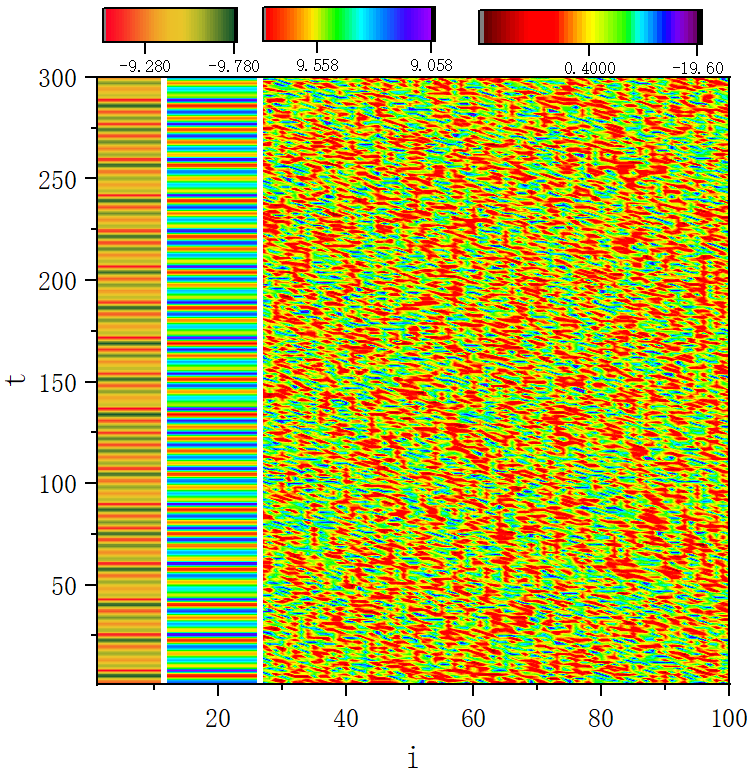
figure 4_B
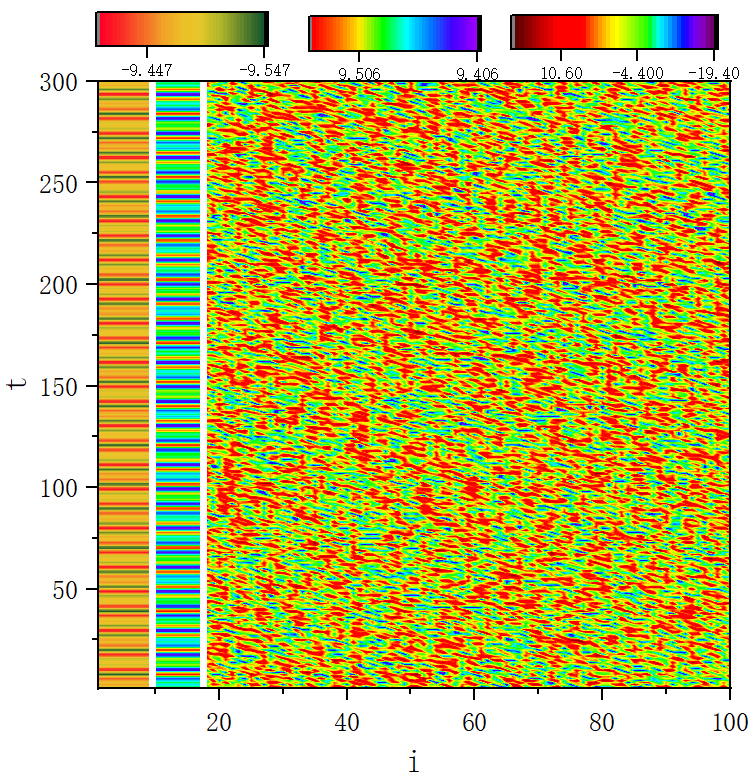
figure 4_C
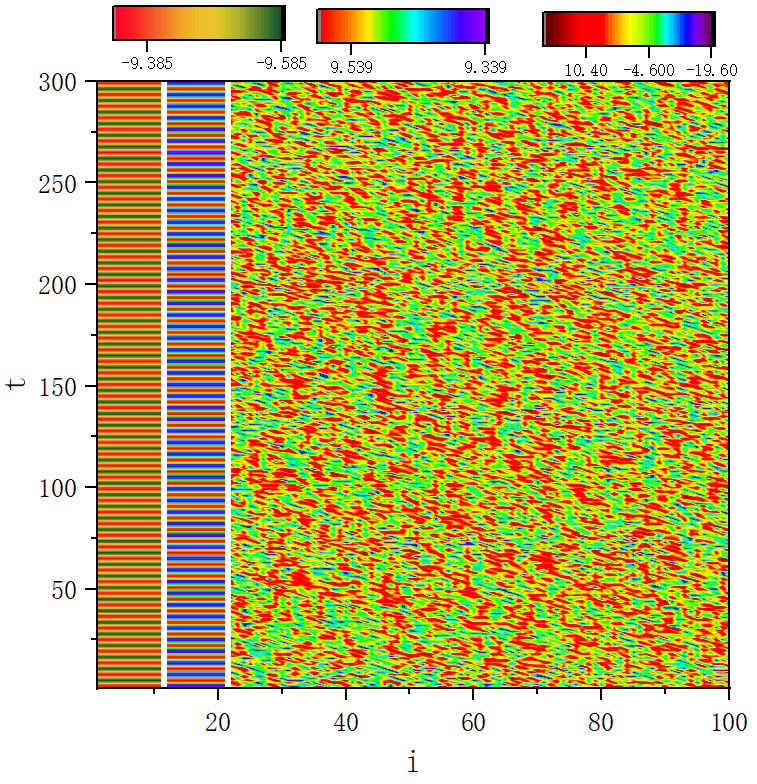
figure 5
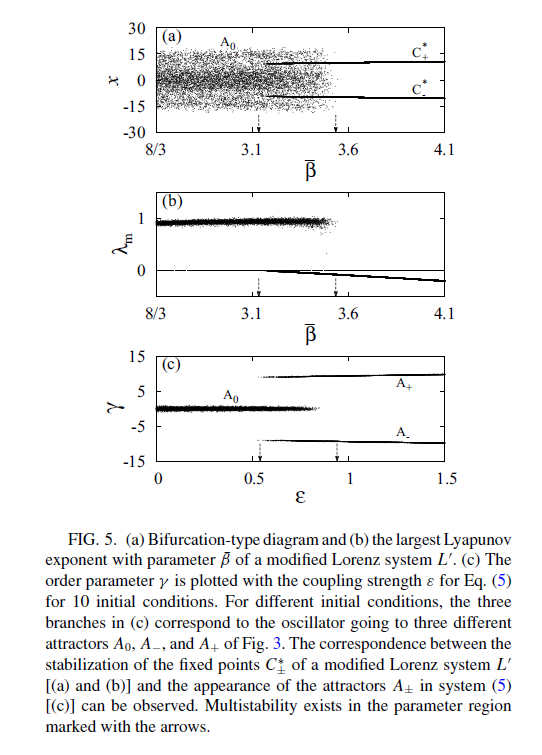
figure 5_A
module Lorenz
implicit none
real,parameter :: h=0.01
integer,parameter :: MaxT=1060000,T_trans=1050000,N=3,M=10
real :: x(M,N),f(MaxT),epsilon
integer,allocatable :: neighbour_matrix(:,:)
contains
subroutine x0()
implicit none
integer :: i
real :: x1,x2,x3
call random_seed()
open(5,file="x0_y0_z0.txt")
do i=1,M,1
call random_number(x1)
call random_number(x2)
call random_number(x3)
x(i,1)=x1*100.0-100.0
x(i,2)=x2*100.0-100.0
x(i,3)=x3*100.0-100.0
write(5,*) x(i,1),x(i,2),x(i,3)
end do
close(5)
end subroutine x0
subroutine fnf(xx,fx,i,t)
implicit none
real :: xx(N),fx(N)
integer :: t,i,j
real :: a,b,c,beta_ave
a=10.0 !sigma
b=8.0/3.0 !beta
c=28.0 !r
beta_ave=(b+epsilon)
fx(1)=a*(xx(2)-xx(1))
fx(2)=c*xx(1)-xx(2)-xx(1)*xx(3)
fx(3)=xx(1)*xx(2)-beta_ave*xx(3)+epsilon*f(t)
return
end subroutine fnf
subroutine rk4(x,t)
implicit none
integer :: i,t
real :: x(M,N),xx(N),fx(N)
real :: kx1(N),kx2(N),kx3(N),kx4(N)
do i=1,M,1
xx=x(i,:)
call fnf(xx,fx,i,t)
kx1=h*fx
xx=x(i,:)+0.5*kx1
call fnf(xx,fx,i,t)
kx2=h*fx
xx=x(i,:)+0.5*kx2
call fnf(xx,fx,i,t)
kx3=h*fx
xx=x(i,:)+kx3
call fnf(xx,fx,i,t)
kx4=h*fx
x(i,:)=x(i,:)+(kx1+2.0*kx2+2.0*kx3+kx4)/6.0
end do
return
end subroutine rk4
!Umax与Umin
subroutine U_max_min(xxx,U_max,U_min)
implicit none
real :: U_max(M),U_min(M),xxx(M)
integer :: i
do i=1,M,1
if(U_max(i)<xxx(i)) then
U_max(i)=xxx(i)
end if
if(U_min(i)>xxx(i)) then
U_min(i)=xxx(i)
end if
end do
return
end subroutine U_max_min
!建立网络结构
subroutine neighbour()
implicit none
integer :: K !单节点K个邻居
integer :: i,j,number
allocate(neighbour_matrix(M,M))
!初始化网络矩阵
neighbour_matrix=0
do i=1,M-1,1
do j=i+1,M,1
neighbour_matrix(i,j)=1
neighbour_matrix(j,i)=1
end do
end do
!输出矩阵
do i=1,M,1
do j=1,M,1
write(10,"(I2)",advance='no') neighbour_matrix(i,j)
end do
write(10,*)
end do
return
end subroutine neighbour
!普通高斯白噪声
subroutine gaussNoise()
implicit none
integer, parameter :: L = MaxT ! 生成噪声的长度
real,parameter :: pi=3.1415926
real :: noise(L) ! 储存噪声的数组
real :: mean = 0.0 ! 均值
real :: std_dev = 1.0 ! 标准差
integer :: seed = 1 ! 随机数种子
integer :: i
open(11,file="noise.txt")
! 生成噪声
call random_seed()
do i = 1, L
call random_number(noise(i))
end do
do i=1,L-1
noise(i) = mean + std_dev * sqrt(-2.0 * log(noise(i))) * cos(2.0 * pi * noise(i + 1))
end do
noise(L)=0.0
! 输出噪声
do i = 1, L
f(i)=noise(i)
write(11,*) i,noise(i)
end do
return
end subroutine gaussNoise
!读取Rossler信号给f(t)
subroutine Rossler_f()
implicit none
integer :: i
real :: x1,x2,x3,x4
open(12,file="Rossler_t_x_y_z.txt")
do i=1,MaxT,1
read(12,*) x1,x2,x3,x4
f(i) = x2
end do
close(12)
return
end subroutine Rossler_f
!cos(a1t)+cos(a2t)
subroutine QP()
implicit none
real :: a1,a2
integer :: i
a1=1.0
a2=0.5*(1.0+sqrt(5.0))
do i=1,MaxT,1
f(i)=cos(a1*i*h)+cos(a2*i*h)
write(11,*) i,f(i)
end do
return
end subroutine QP
end module Lorenz
program main
use Lorenz
implicit none
integer :: t,i,j
real :: U_max(M),U_min(M),data(M,MaxT-T_trans,3)
open(10,file="neighbour_matrix.txt")
open(20,file="i_t_x_B-.txt")
open(21,file="i_t_x_B+.txt")
open(22,file="i_t_x_B0.txt")
open(30,file="xmax_xmin.txt")
open(40,file="t_x_1.txt")
open(41,file="t_x_4.txt")
open(42,file="t_x_8.txt")
open(43,file="t_x_17.txt")
open(44,file="t_x_29.txt")
open(45,file="t_x_20.txt")
open(46,file="t_x_26.txt")
open(50,file="t_x_1_data.txt")
open(60,file="beta_ave_x.txt")
call neighbour()
! call gaussNoise()
! call Rossler_f()
!call QP()
do j=1,144,1
call x0
epsilon=j*0.01
write(*,*) epsilon+8.0/3.0
U_max=-1000.0
U_min=1000.0
f=0.0
do t=1,MaxT,1
call rk4(x,t)
if(t>T_trans) then
call U_max_min(x(:,1),U_max,U_min)
if(mod(t,10000)==0) then
do i=1,M,1
write(60,*) epsilon+8.0/3.0,i,x(i,1)
end do
end if
!write(40,*) (t-T_trans)*h,x(1,1),x(1,2),x(1,3)
! write(41,*) (t-T_trans)*h,x(4,1),x(4,2),x(4,3)
! write(42,*) (t-T_trans)*h,x(8,1),x(8,2),x(8,3)
! write(43,*) (t-T_trans)*h,x(17,1),x(17,2),x(17,3)
! write(44,*) (t-T_trans)*h,x(29,1),x(29,2),x(29,3)
! write(45,*) (t-T_trans)*h,x(20,1),x(20,2),x(20,3)
! write(46,*) (t-T_trans)*h,x(26,1),x(26,2),x(26,3)
!将相同的动力学模式放在一起
! do i=1,M,1
! data(i,t-T_trans,1) = x(i,1)
! data(i,t-T_trans,2) = x(i,2)
! data(i,t-T_trans,3) = x(i,3)
! end do
end if
end do
do i=1,M,1
write(30,*) epsilon+8.0/3.0,i,U_max(i),U_min(i)
! do t=1,MaxT-T_trans,1
! if(abs(U_max(i))-abs(U_min(i))<5.0.and.U_max(i)<0) then
! !B-
! if(mod(t,100)==0) then
! write(20,*) i,t,data(i,t,1),data(i,t,2),data(i,t,3)
! end if
! else if(abs(U_max(i))-abs(U_min(i))<5.0.and.U_min(i)>0) then
! !B+
! if(mod(t,100)==0) then
! write(21,*) i,t,data(i,t,1),data(i,t,2),data(i,t,3)
! end if
! else if(U_max(i)-U_min(i)>5.0.and.U_min(i)<0.and.U_max(i)>0) then
! !B0
! if(mod(t,100)==0) then
! write(22,*) i,t,data(i,t,1),data(i,t,2),data(i,t,3)
! end if
! else
! write(60,*) "条件有误!"
! end if
! end do
end do
end do
close(10)
close(20)
close(30)
close(40)
deallocate(neighbour_matrix)
end program main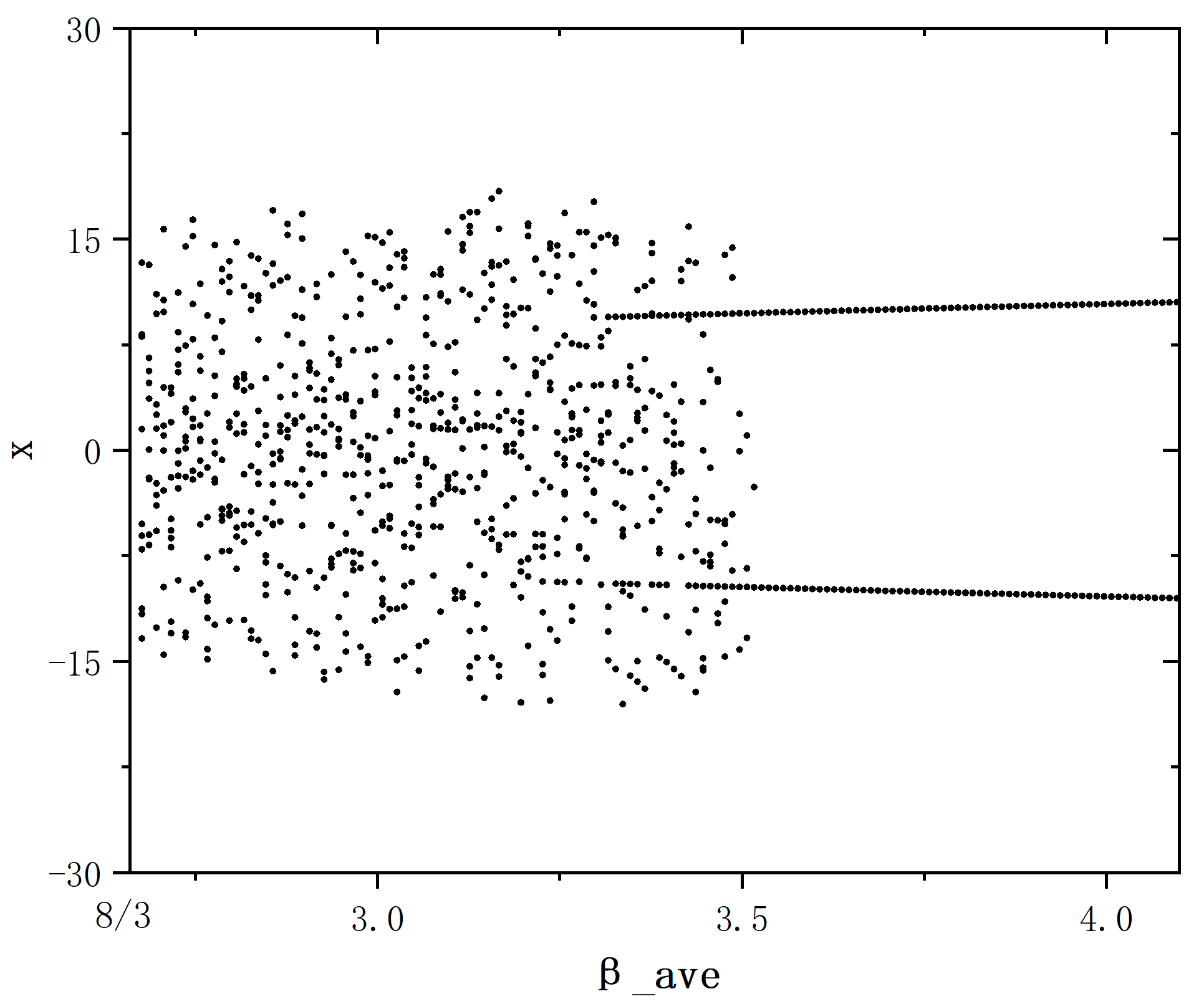
figure 5_B
module Lorenz
implicit none
real,parameter :: h=0.01
integer,parameter :: MaxT=250000,N=3,M=1,T_trans=200000
real(kind=8) :: x1(M,N),x2(M,N),f(MaxT)
real :: epsilon
contains
subroutine x0()
implicit none
integer :: i
real(kind=8) :: x11,x22,x33
call random_seed()
open(5,file="x0_y0_z0.txt")
do i=1,M,1
call random_number(x11)
call random_number(x22)
call random_number(x33)
x1(i,1)=x11*100.0-100.0
x1(i,2)=x22*100.0-100.0
x1(i,3)=x33*100.0-100.0
write(5,*) x1(i,1),x1(i,2),x1(i,3)
end do
close(5)
end subroutine x0
subroutine fnf(xx,fx,i)
implicit none
real(kind=8) :: xx(N),fx(N)
integer :: t,i,j
real(kind=8) :: a,b,c,beta_ave
a=10.0 !sigma
b=8.0/3.0 !beta
c=28.0 !r
beta_ave=(b+epsilon)
fx(1)=a*(xx(2)-xx(1))
fx(2)=c*xx(1)-xx(2)-xx(1)*xx(3)
fx(3)=xx(1)*xx(2)-beta_ave*xx(3)+epsilon*f(t)
return
end subroutine fnf
subroutine rk4(x)
implicit none
integer :: i
real(kind=8) :: x(M,N),xx(N),fx(N)
real(kind=8) :: kx1(N),kx2(N),kx3(N),kx4(N)
do i=1,M,1
xx=x(i,:)
call fnf(xx,fx,i)
kx1=h*fx
xx=x(i,:)+0.5*kx1
call fnf(xx,fx,i)
kx2=h*fx
xx=x(i,:)+0.5*kx2
call fnf(xx,fx,i)
kx3=h*fx
xx=x(i,:)+kx3
call fnf(xx,fx,i)
kx4=h*fx
x(i,:)=x(i,:)+(kx1+2.0*kx2+2.0*kx3+kx4)/6.0
end do
return
end subroutine rk4
end module Lorenz
program main
use Lorenz
implicit none
integer :: t,i,j
real(kind=8) :: d1=0.0,d0,lam,lamda
open(10,file="beta_ave_lamda.txt")
d0=1.0e-7
!初值基准点
do i=1,144,1
do j=1,100,1
lam=0.0
lamda=0.0
f=0.0
epsilon=i*0.01
call x0()
x2=x1
x2(1,3)=x1(1,3)+d0
do t=1,MaxT,1
call rk4(x1)
call rk4(x2)
d1=sqrt((x2(1,1)-x1(1,1))**2+(x2(1,2)-x1(1,2))**2+(x2(1,3)-x1(1,3))**2)
!新的偏离点在上一次计算的两轨迹末端的连线上,且距离仍等于d0
x2(1,1)=x1(1,1)+(d0/d1)*(x2(1,1)-x1(1,1))
x2(1,2)=x1(1,2)+(d0/d1)*(x2(1,2)-x1(1,2))
x2(1,3)=x1(1,3)+(d0/d1)*(x2(1,3)-x1(1,3))
if(t>T_trans) then
lam=lam+log(d1/d0)
end if
end do
lamda=lam/((MaxT-T_trans-1))/h
write(10,*) j,epsilon+8.0/3.0,lamda
write(*,*) j,epsilon+8.0/3.0,lamda
end do
end do
close(10)
end program main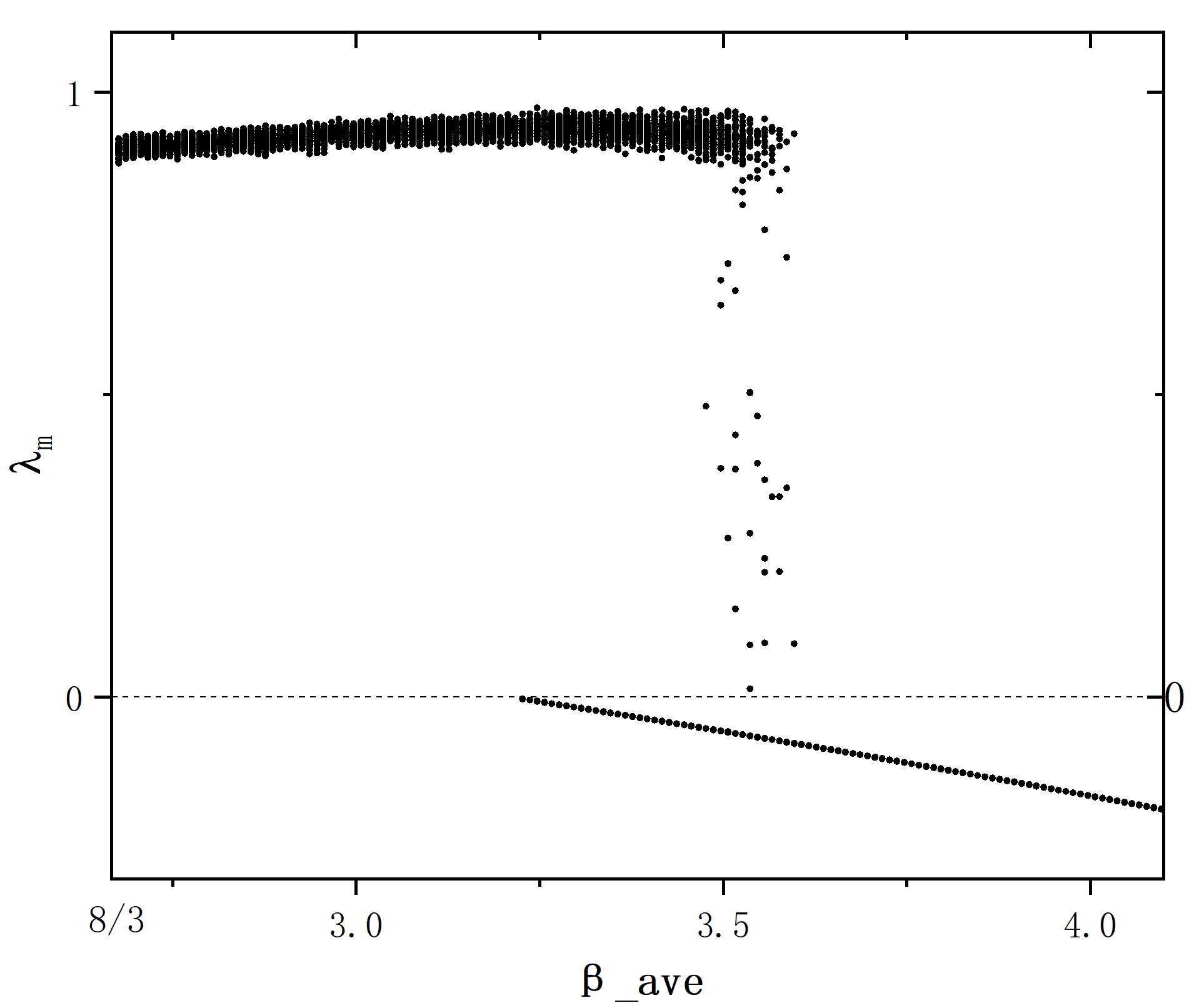
figure 5_C
module Lorenz
implicit none
real,parameter :: h=0.01
integer,parameter :: MaxT=1060000,T_trans=1050000,N=3,M=100
real :: x(M,N),f(MaxT),epsilon
integer,allocatable :: neighbour_matrix(:,:)
contains
subroutine x0()
implicit none
integer :: i
real :: x1,x2,x3
call random_seed()
open(5,file="x0_y0_z0.txt")
do i=1,M,1
call random_number(x1)
call random_number(x2)
call random_number(x3)
x(i,1)=x1*100.0-100.0
x(i,2)=x2*100.0-100.0
x(i,3)=x3*100.0-100.0
! write(5,*) x(i,1),x(i,2),x(i,3)
end do
close(5)
end subroutine x0
subroutine fnf(xx,fx,i,t)
implicit none
real :: xx(N),fx(N)
integer :: t,i,j
real :: a,b,c
a=10.0 !sigma
b=8.0/3.0 !beta
c=28.0 !r
fx(1)=a*(xx(2)-xx(1))
fx(2)=c*xx(1)-xx(2)-xx(1)*xx(3)
fx(3)=xx(1)*xx(2)-b*xx(3)+epsilon*(f(t)-xx(3))
return
end subroutine fnf
subroutine rk4(x,t)
implicit none
integer :: i,t
real :: x(M,N),xx(N),fx(N)
real :: kx1(N),kx2(N),kx3(N),kx4(N)
do i=1,M,1
xx=x(i,:)
call fnf(xx,fx,i,t)
kx1=h*fx
xx=x(i,:)+0.5*kx1
call fnf(xx,fx,i,t)
kx2=h*fx
xx=x(i,:)+0.5*kx2
call fnf(xx,fx,i,t)
kx3=h*fx
xx=x(i,:)+kx3
call fnf(xx,fx,i,t)
kx4=h*fx
x(i,:)=x(i,:)+(kx1+2.0*kx2+2.0*kx3+kx4)/6.0
end do
return
end subroutine rk4
!Umax与Umin
subroutine U_max_min(xxx,U_max,U_min)
implicit none
real :: U_max(M),U_min(M),xxx(M)
integer :: i
do i=1,M,1
if(U_max(i)<xxx(i)) then
U_max(i)=xxx(i)
end if
if(U_min(i)>xxx(i)) then
U_min(i)=xxx(i)
end if
end do
return
end subroutine U_max_min
!建立网络结构
subroutine neighbour()
implicit none
integer :: K !单节点K个邻居
integer :: i,j,number
allocate(neighbour_matrix(M,M))
!初始化网络矩阵
neighbour_matrix=0
do i=1,M-1,1
do j=i+1,M,1
neighbour_matrix(i,j)=1
neighbour_matrix(j,i)=1
end do
end do
!输出矩阵
do i=1,M,1
do j=1,M,1
write(10,"(I2)",advance='no') neighbour_matrix(i,j)
end do
write(10,*)
end do
return
end subroutine neighbour
!普通高斯白噪声
subroutine gaussNoise()
implicit none
integer, parameter :: L = MaxT ! 生成噪声的长度
real,parameter :: pi=3.1415926
real :: noise(L) ! 储存噪声的数组
real :: mean = 0.0 ! 均值
real :: std_dev = 1.0 ! 标准差
integer :: seed = 1 ! 随机数种子
integer :: i
open(11,file="noise.txt")
! 生成噪声
call random_seed()
do i = 1, L
call random_number(noise(i))
end do
do i=1,L-1
noise(i) = mean + std_dev * sqrt(-2.0 * log(noise(i))) * cos(2.0 * pi * noise(i + 1))
end do
noise(L)=0.0
! 输出噪声
do i = 1, L
f(i)=noise(i)
write(11,*) i,noise(i)
end do
return
end subroutine gaussNoise
!读取Rossler信号给f(t)
subroutine Rossler_f()
implicit none
integer :: i
real :: x1,x2,x3,x4
open(12,file="Rossler_t_x_y_z.txt")
do i=1,MaxT,1
read(12,*) x1,x2,x3,x4
f(i) = x2
end do
close(12)
return
end subroutine Rossler_f
!cos(a1t)+cos(a2t)
subroutine QP()
implicit none
real :: a1,a2
integer :: i
a1=1.0
a2=0.5*(1.0+sqrt(5.0))
do i=1,MaxT,1
f(i)=cos(a1*i*h)+cos(a2*i*h)
write(11,*) i,f(i)
end do
return
end subroutine QP
end module Lorenz
program main
use Lorenz
implicit none
integer :: t,i,j
real :: U_max(M),U_min(M),data(M,MaxT-T_trans,3)
open(10,file="neighbour_matrix.txt")
open(20,file="i_t_x_B-.txt")
open(21,file="i_t_x_B+.txt")
open(22,file="i_t_x_B0.txt")
open(30,file="xmax_xmin.txt")
open(40,file="t_x_1.txt")
open(41,file="t_x_4.txt")
open(42,file="t_x_8.txt")
open(43,file="t_x_17.txt")
open(44,file="t_x_29.txt")
open(45,file="t_x_20.txt")
open(46,file="t_x_26.txt")
open(50,file="t_x_1_data.txt")
open(60,file="beta_ave_x.txt")
call neighbour()
! call Rossler_f()
!call QP()
do j=1,151,1
call x0
epsilon=j*0.01-0.01
write(*,*) epsilon
U_max=-1000.0
U_min=1000.0
call gaussNoise()
do t=1,MaxT,1
call rk4(x,t)
if(t>T_trans) then
call U_max_min(x(:,1),U_max,U_min)
end if
end do
do i=1,M,1
write(30,*) epsilon,i,(U_max(i)+U_min(i))/2.0
end do
end do
close(10)
close(20)
close(30)
close(40)
deallocate(neighbour_matrix)
end program main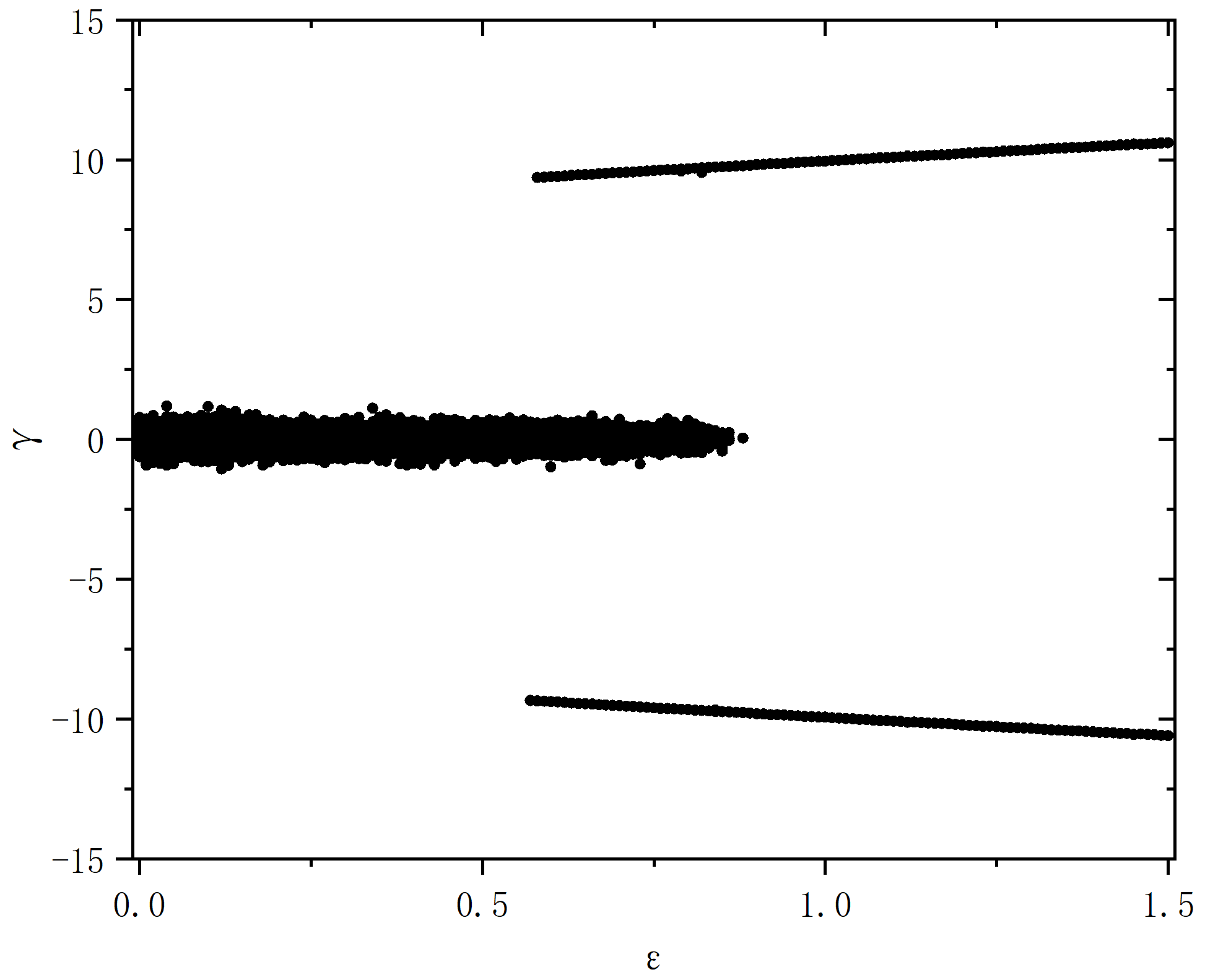
figure 6
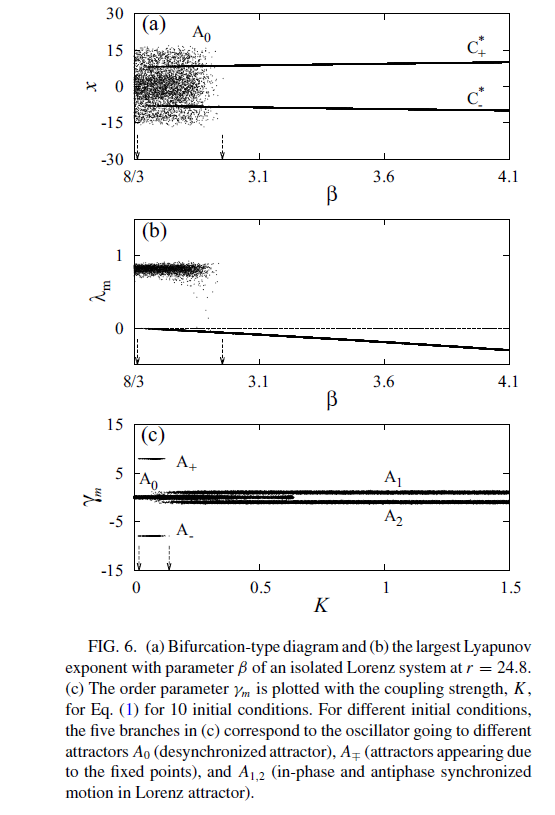
figure 6_A
module Lorenz
implicit none
real,parameter :: h=0.01
integer,parameter :: MaxT=1060000,T_trans=1050000,N=3,M=50
real :: x(M,N),f(MaxT),beta
integer,allocatable :: neighbour_matrix(:,:)
contains
subroutine x0()
implicit none
integer :: i
real :: x1,x2,x3
call random_seed()
open(5,file="x0_y0_z0.txt")
do i=1,M,1
call random_number(x1)
call random_number(x2)
call random_number(x3)
x(i,1)=x1*100.0-100.0
x(i,2)=x2*100.0-100.0
x(i,3)=x3*100.0-100.0
write(5,*) x(i,1),x(i,2),x(i,3)
end do
close(5)
end subroutine x0
subroutine fnf(xx,fx,i,t)
implicit none
real :: xx(N),fx(N)
integer :: t,i,j
real :: a,b,c
a=10.0 !sigma
b=beta !beta
c=24.8 !r
fx(1)=a*(xx(2)-xx(1))
fx(2)=c*xx(1)-xx(2)-xx(1)*xx(3)
fx(3)=xx(1)*xx(2)-b*xx(3)
return
end subroutine fnf
subroutine rk4(x,t)
implicit none
integer :: i,t
real :: x(M,N),xx(N),fx(N)
real :: kx1(N),kx2(N),kx3(N),kx4(N)
do i=1,M,1
xx=x(i,:)
call fnf(xx,fx,i,t)
kx1=h*fx
xx=x(i,:)+0.5*kx1
call fnf(xx,fx,i,t)
kx2=h*fx
xx=x(i,:)+0.5*kx2
call fnf(xx,fx,i,t)
kx3=h*fx
xx=x(i,:)+kx3
call fnf(xx,fx,i,t)
kx4=h*fx
x(i,:)=x(i,:)+(kx1+2.0*kx2+2.0*kx3+kx4)/6.0
end do
return
end subroutine rk4
!Umax与Umin
subroutine U_max_min(xxx,U_max,U_min)
implicit none
real :: U_max(M),U_min(M),xxx(M)
integer :: i
do i=1,M,1
if(U_max(i)<xxx(i)) then
U_max(i)=xxx(i)
end if
if(U_min(i)>xxx(i)) then
U_min(i)=xxx(i)
end if
end do
return
end subroutine U_max_min
!建立网络结构
subroutine neighbour()
implicit none
integer :: K !单节点K个邻居
integer :: i,j,number
allocate(neighbour_matrix(M,M))
!初始化网络矩阵
neighbour_matrix=0
do i=1,M-1,1
do j=i+1,M,1
neighbour_matrix(i,j)=1
neighbour_matrix(j,i)=1
end do
end do
!输出矩阵
do i=1,M,1
do j=1,M,1
write(10,"(I2)",advance='no') neighbour_matrix(i,j)
end do
write(10,*)
end do
return
end subroutine neighbour
!普通高斯白噪声
subroutine gaussNoise()
implicit none
integer, parameter :: L = MaxT ! 生成噪声的长度
real,parameter :: pi=3.1415926
real :: noise(L) ! 储存噪声的数组
real :: mean = 0.0 ! 均值
real :: std_dev = 1.0 ! 标准差
integer :: seed = 1 ! 随机数种子
integer :: i
open(11,file="noise.txt")
! 生成噪声
call random_seed()
do i = 1, L
call random_number(noise(i))
end do
do i=1,L-1
noise(i) = mean + std_dev * sqrt(-2.0 * log(noise(i))) * cos(2.0 * pi * noise(i + 1))
end do
noise(L)=0.0
! 输出噪声
do i = 1, L
f(i)=noise(i)
write(11,*) i,noise(i)
end do
return
end subroutine gaussNoise
!读取Rossler信号给f(t)
subroutine Rossler_f()
implicit none
integer :: i
real :: x1,x2,x3,x4
open(12,file="Rossler_t_x_y_z.txt")
do i=1,MaxT,1
read(12,*) x1,x2,x3,x4
f(i) = x2
end do
close(12)
return
end subroutine Rossler_f
!cos(a1t)+cos(a2t)
subroutine QP()
implicit none
real :: a1,a2
integer :: i
a1=1.0
a2=0.5*(1.0+sqrt(5.0))
do i=1,MaxT,1
f(i)=cos(a1*i*h)+cos(a2*i*h)
write(11,*) i,f(i)
end do
return
end subroutine QP
end module Lorenz
program main
use Lorenz
implicit none
integer :: t,i,j
real :: U_max(M),U_min(M),data(M,MaxT-T_trans,3)
open(10,file="neighbour_matrix.txt")
open(20,file="i_t_x_B-.txt")
open(21,file="i_t_x_B+.txt")
open(22,file="i_t_x_B0.txt")
open(30,file="xmax_xmin.txt")
open(40,file="t_x_1.txt")
open(41,file="t_x_4.txt")
open(42,file="t_x_8.txt")
open(43,file="t_x_17.txt")
open(44,file="t_x_29.txt")
open(45,file="t_x_20.txt")
open(46,file="t_x_26.txt")
open(50,file="t_x_1_data.txt")
open(60,file="beta_ave_x.txt")
call neighbour()
! call gaussNoise()
! call Rossler_f()
!call QP()
do j=1,145,1
call x0
beta=8.0/3.0+j*0.01-0.01
write(*,*) beta
U_max=-1000.0
U_min=1000.0
f=0.0
do t=1,MaxT,1
call rk4(x,t)
if(t>T_trans) then
call U_max_min(x(:,1),U_max,U_min)
if(mod(t,10000)==0) then
do i=1,M,1
write(60,*) beta,i,x(i,1)
end do
end if
end if
end do
do i=1,M,1
write(30,*) beta,i,U_max(i),U_min(i)
end do
end do
close(10)
close(20)
close(30)
close(40)
deallocate(neighbour_matrix)
end program main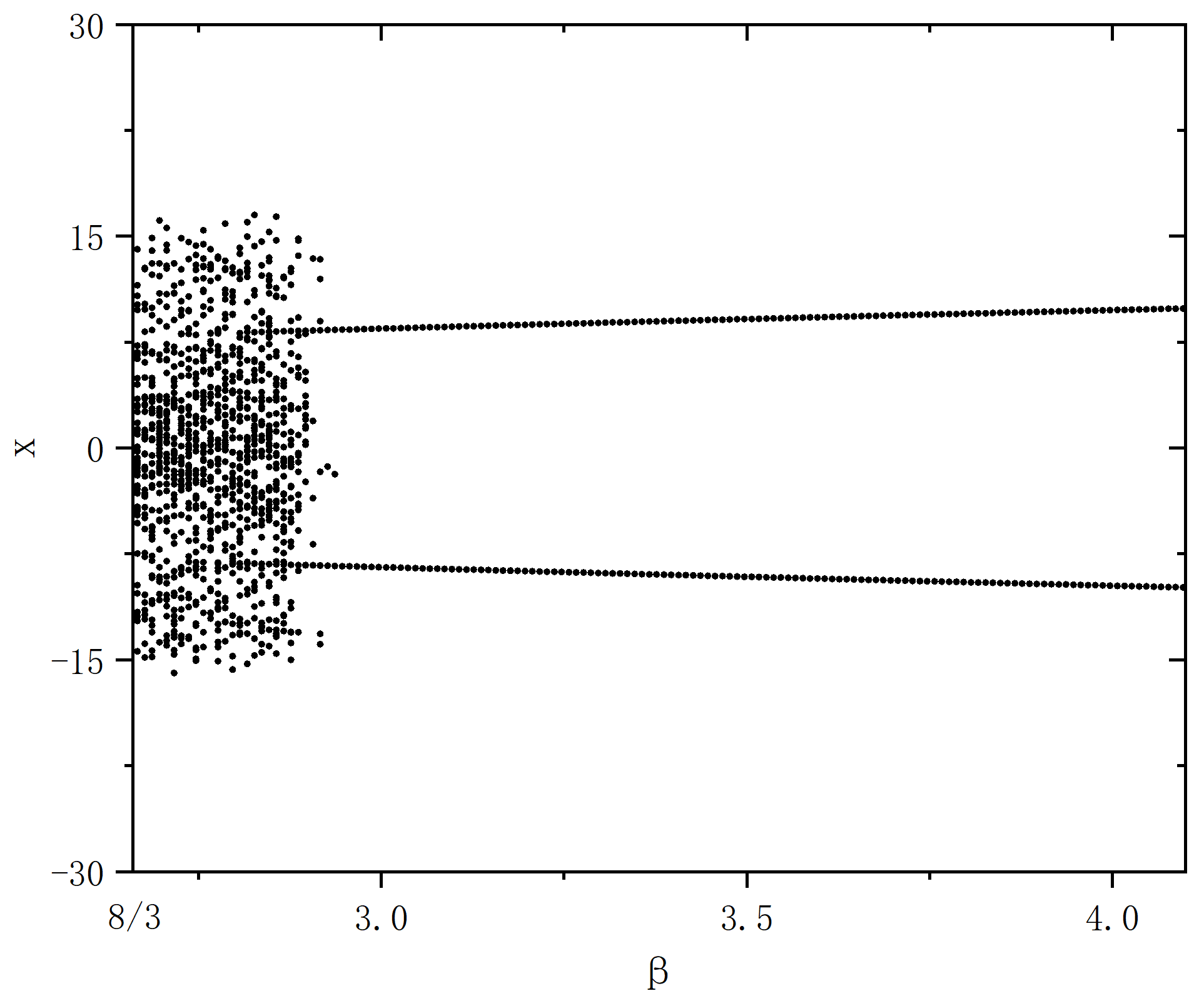
figure 6_B
module Lorenz
implicit none
real,parameter :: h=0.01
integer,parameter :: MaxT=250000,N=3,M=1,T_trans=200000
real(kind=8) :: x1(M,N),x2(M,N),f(MaxT)
real :: beta
contains
subroutine x0()
implicit none
integer :: i
real(kind=8) :: x11,x22,x33
call random_seed()
open(5,file="x0_y0_z0.txt")
do i=1,M,1
call random_number(x11)
call random_number(x22)
call random_number(x33)
x1(i,1)=x11*100.0-100.0
x1(i,2)=x22*100.0-100.0
x1(i,3)=x33*100.0-100.0
write(5,*) x1(i,1),x1(i,2),x1(i,3)
end do
close(5)
end subroutine x0
subroutine fnf(xx,fx,i)
implicit none
real(kind=8) :: xx(N),fx(N)
integer :: t,i,j
real(kind=8) :: a,b,c
a=10.0 !sigma
b=beta !beta
c=24.8 !r
fx(1)=a*(xx(2)-xx(1))
fx(2)=c*xx(1)-xx(2)-xx(1)*xx(3)
fx(3)=xx(1)*xx(2)-b*xx(3)
return
end subroutine fnf
subroutine rk4(x)
implicit none
integer :: i
real(kind=8) :: x(M,N),xx(N),fx(N)
real(kind=8) :: kx1(N),kx2(N),kx3(N),kx4(N)
do i=1,M,1
xx=x(i,:)
call fnf(xx,fx,i)
kx1=h*fx
xx=x(i,:)+0.5*kx1
call fnf(xx,fx,i)
kx2=h*fx
xx=x(i,:)+0.5*kx2
call fnf(xx,fx,i)
kx3=h*fx
xx=x(i,:)+kx3
call fnf(xx,fx,i)
kx4=h*fx
x(i,:)=x(i,:)+(kx1+2.0*kx2+2.0*kx3+kx4)/6.0
end do
return
end subroutine rk4
end module Lorenz
program main
use Lorenz
implicit none
integer :: t,i,j
real(kind=8) :: d1=0.0,d0,lam,lamda
open(10,file="beta_ave_lamda.txt")
d0=1.0e-7
!初值基准点
do i=1,144,1
do j=1,100,1
lam=0.0
lamda=0.0
f=0.0
beta=i*0.01+8.0/3.0
call x0()
x2=x1
x2(1,3)=x1(1,3)+d0
do t=1,MaxT,1
call rk4(x1)
call rk4(x2)
d1=sqrt((x2(1,1)-x1(1,1))**2+(x2(1,2)-x1(1,2))**2+(x2(1,3)-x1(1,3))**2)
!新的偏离点在上一次计算的两轨迹末端的连线上,且距离仍等于d0
x2(1,1)=x1(1,1)+(d0/d1)*(x2(1,1)-x1(1,1))
x2(1,2)=x1(1,2)+(d0/d1)*(x2(1,2)-x1(1,2))
x2(1,3)=x1(1,3)+(d0/d1)*(x2(1,3)-x1(1,3))
if(t>T_trans) then
lam=lam+log(d1/d0)
end if
end do
lamda=lam/((MaxT-T_trans-1))/h
write(10,*) j,beta,lamda
write(*,*) j,beta,lamda
end do
end do
close(10)
end program main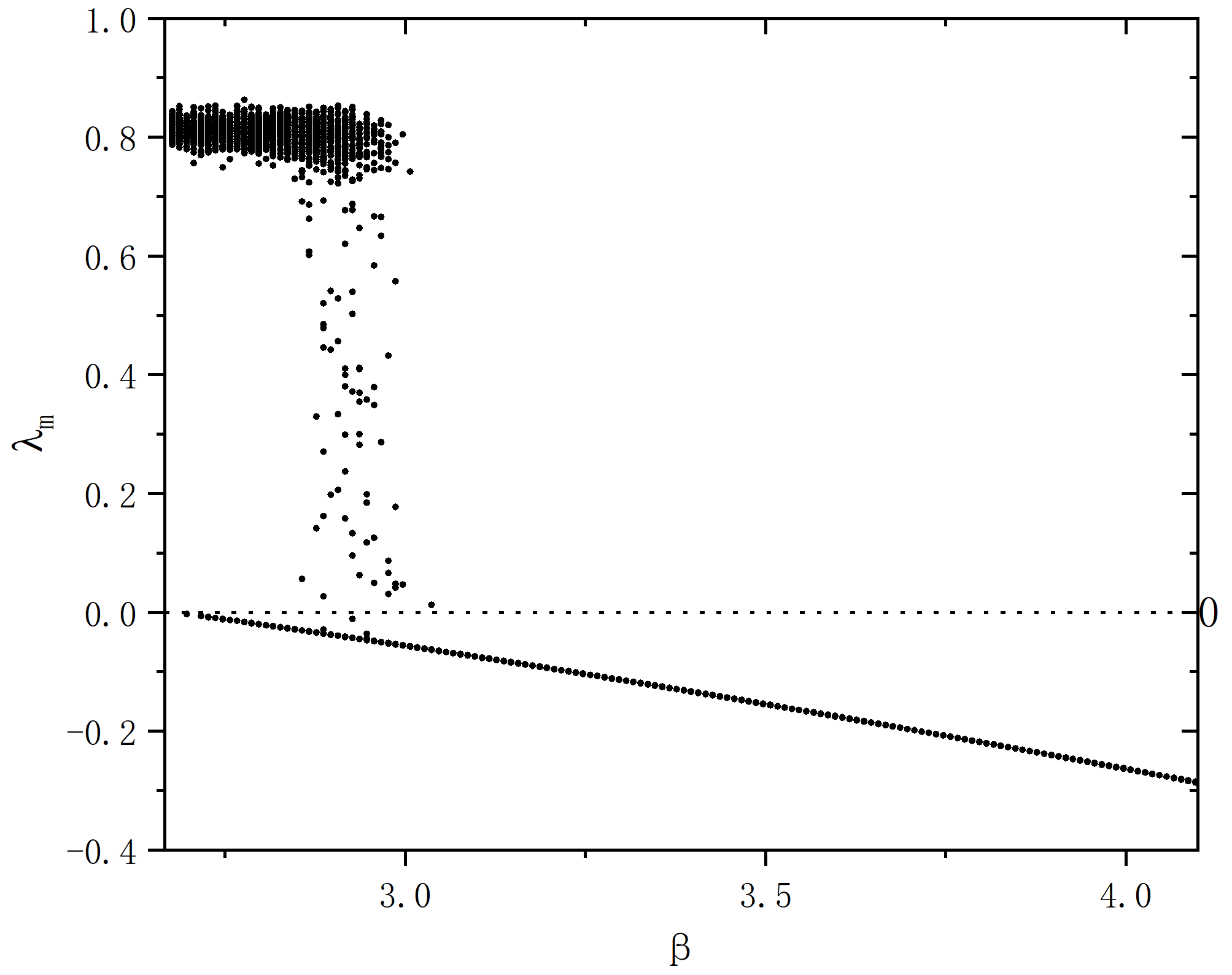
figure 6_C
module Lorenz
implicit none
real,parameter :: h=0.01
integer,parameter :: MaxT=1060000,T_trans=1050000,N=3,M=10
real :: x(M,N),f(MaxT),K
integer,allocatable :: neighbour_matrix(:,:)
contains
subroutine x0()
implicit none
integer :: i
real :: x1,x2,x3
call random_seed()
open(5,file="x0_y0_z0.txt")
do i=1,M,1
call random_number(x1)
call random_number(x2)
call random_number(x3)
x(i,1)=x1*100.0-100.0
x(i,2)=x2*100.0-100.0
x(i,3)=x3*100.0-100.0
! write(5,*) x(i,1),x(i,2),x(i,3)
end do
close(5)
end subroutine x0
subroutine fnf(xx,fx,i,t)
implicit none
real :: xx(N),fx(N),coupling
integer :: t,i,j
real :: a,b,c
a=10.0 !sigma
b=8.0/3.0 !beta
c=24.74 !r
coupling=0.0
do j=1,M,1
coupling=coupling+neighbour_matrix(i,j)*(x(j,3)-x(i,3))
end do
fx(1)=a*(xx(2)-xx(1))
fx(2)=c*xx(1)-xx(2)-xx(1)*xx(3)
fx(3)=xx(1)*xx(2)-b*xx(3)+(K/real(M-1))*coupling
return
end subroutine fnf
subroutine rk4(x,t)
implicit none
integer :: i,t
real :: x(M,N),xx(N),fx(N)
real :: kx1(N),kx2(N),kx3(N),kx4(N)
do i=1,M,1
xx=x(i,:)
call fnf(xx,fx,i,t)
kx1=h*fx
xx=x(i,:)+0.5*kx1
call fnf(xx,fx,i,t)
kx2=h*fx
xx=x(i,:)+0.5*kx2
call fnf(xx,fx,i,t)
kx3=h*fx
xx=x(i,:)+kx3
call fnf(xx,fx,i,t)
kx4=h*fx
x(i,:)=x(i,:)+(kx1+2.0*kx2+2.0*kx3+kx4)/6.0
end do
return
end subroutine rk4
!Umax与Umin
subroutine U_max_min(xxx,U_max,U_min)
implicit none
real :: U_max(M),U_min(M),xxx(M)
integer :: i
do i=1,M,1
if(U_max(i)<xxx(i)) then
U_max(i)=xxx(i)
end if
if(U_min(i)>xxx(i)) then
U_min(i)=xxx(i)
end if
end do
return
end subroutine U_max_min
!建立网络结构
subroutine neighbour()
implicit none
integer :: K !单节点K个邻居
integer :: i,j,number
allocate(neighbour_matrix(M,M))
!初始化网络矩阵
neighbour_matrix=0
do i=1,M-1,1
do j=i+1,M,1
neighbour_matrix(i,j)=1
neighbour_matrix(j,i)=1
end do
end do
!输出矩阵
do i=1,M,1
do j=1,M,1
write(10,"(I2)",advance='no') neighbour_matrix(i,j)
end do
write(10,*)
end do
return
end subroutine neighbour
!普通高斯白噪声
subroutine gaussNoise()
implicit none
integer, parameter :: L = MaxT ! 生成噪声的长度
real,parameter :: pi=3.1415926
real :: noise(L) ! 储存噪声的数组
real :: mean = 0.0 ! 均值
real :: std_dev = 1.0 ! 标准差
integer :: seed = 1 ! 随机数种子
integer :: i
open(11,file="noise.txt")
! 生成噪声
call random_seed()
do i = 1, L
call random_number(noise(i))
end do
do i=1,L-1
noise(i) = mean + std_dev * sqrt(-2.0 * log(noise(i))) * cos(2.0 * pi * noise(i + 1))
end do
noise(L)=0.0
! 输出噪声
do i = 1, L
f(i)=noise(i)
write(11,*) i,noise(i)
end do
return
end subroutine gaussNoise
!读取Rossler信号给f(t)
subroutine Rossler_f()
implicit none
integer :: i
real :: x1,x2,x3,x4
open(12,file="Rossler_t_x_y_z.txt")
do i=1,MaxT,1
read(12,*) x1,x2,x3,x4
f(i) = x2
end do
close(12)
return
end subroutine Rossler_f
!cos(a1t)+cos(a2t)
subroutine QP()
implicit none
real :: a1,a2
integer :: i
a1=1.0
a2=0.5*(1.0+sqrt(5.0))
do i=1,MaxT,1
f(i)=cos(a1*i*h)+cos(a2*i*h)
write(11,*) i,f(i)
end do
return
end subroutine QP
end module Lorenz
program main
use Lorenz
implicit none
integer :: t,i,j
real :: U_max(M),U_min(M),gamma_m,gamma,gamma_state,x_direction(M,2),y_direction(M,2)
open(10,file="neighbour_matrix.txt")
open(20,file="i_t_x_B-.txt")
open(21,file="i_t_x_B+.txt")
open(22,file="i_t_x_B0.txt")
open(30,file="xmax_xmin.txt")
open(40,file="t_x_1.txt")
open(41,file="t_x_4.txt")
open(42,file="t_x_8.txt")
open(43,file="t_x_17.txt")
open(44,file="t_x_29.txt")
open(45,file="t_x_20.txt")
open(46,file="t_x_26.txt")
open(50,file="t_x_1_data.txt")
open(60,file="beta_ave_x.txt")
open(70,file="i_K_gamma_m.txt")
call neighbour()
!call Rossler_f()
!call QP()
!call gaussNoise()
do j=1,151,1
call x0
K=j*0.01-0.01
! write(*,*) K
U_max=-1000.0
U_min=1000.0
x_direction=0.0
y_direction=0.0
gamma_state=0.0
do t=1,MaxT,1
call rk4(x,t)
if(t>T_trans) then
call U_max_min(x(:,1),U_max,U_min)
if(t==T_trans+10) then
x_direction(:,1)=x(:,1)
y_direction(:,1)=x(:,2)
end if
if(t==T_trans+5) then
x_direction(:,2)=x(:,1)
y_direction(:,2)=x(:,2)
end if
end if
end do
do i=1,M,1
gamma=(U_max(i)+U_min(i))/2.0
!判断:同相运动gamma_state=1,反向运动gamma_state=-1,去同步gamma_state=0
! if((U_max(i)>0.0.and.U_max(i)>0.0).or.(U_max(i)<0.0.and.U_max(i)<0.0).and.abs(U_max(i))-abs(U_min(i))<1.0) then
! gamma_state=0.0
! else if(U_max(i)>0.0.and.U_min(i)<0.0) then
! if(x_direction(i,1)>0.0.and.y_direction(i,1)>0.0) then
! !第一象限
! if(x_direction(i,1)<x_direction(i,2)) then
! gamma_state=1.0
! else
! gamma_state=-1.0
! end if
! else if(x_direction(i,1)<0.0.and.y_direction(i,1)>0.0) then
! !第二象限
! if(x_direction(i,1)<x_direction(i,2)) then
! gamma_state=1.0
! else
! gamma_state=-1.0
! end if
! else if(x_direction(i,1)<0.0.and.y_direction(i,1)<0.0) then
! !第三象限
! if(x_direction(i,1)>x_direction(i,2)) then
! gamma_state=1.0
! else
! gamma_state=-1.0
! end if
! else if(x_direction(i,1)>0.0.and.y_direction(i,1)<0.0) then
! !第四象限
! if(x_direction(i,1)>x_direction(i,2)) then
! gamma_state=1.0
! else
! gamma_state=-1.0
! end if
! end if
! end if
! gamma_m=gamma+gamma_state
write(70,*) i,K,gamma
write(*,*) i,K,gamma
end do
end do
close(10)
close(20)
close(30)
close(40)
deallocate(neighbour_matrix)
end program mainfigure 7
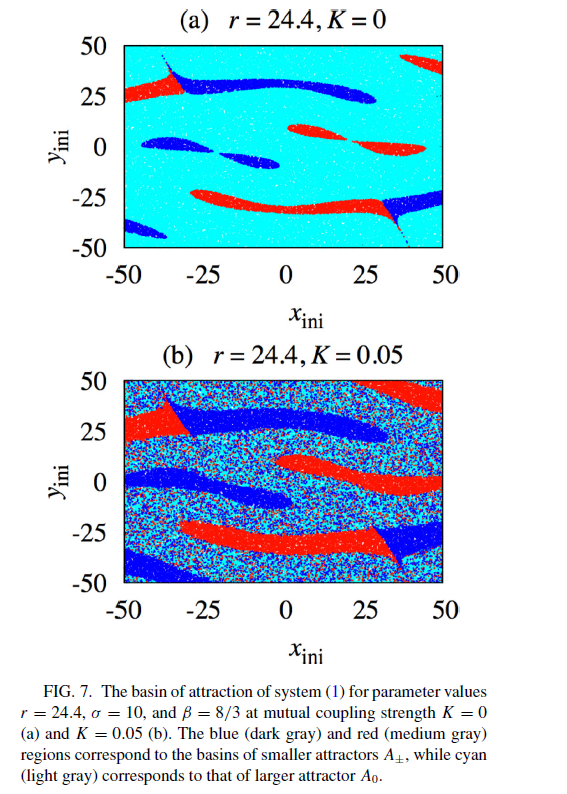
figure 7_A
module Lorenz
implicit none
real,parameter :: h=0.01
integer,parameter :: MaxT=1060000,T_trans=1050000,N=3,M=10
real :: x(M,N),f(MaxT)
integer,allocatable :: neighbour_matrix(:,:)
contains
subroutine x0(xini,yini)
implicit none
integer :: i
do i=1,M,1
x(i,1)=xini
x(i,2)=yini
x(i,3)=0.0
end do
end subroutine x0
subroutine fnf(xx,fx,i)
implicit none
real :: xx(N),fx(N),coupling
integer :: t,i,j
real :: a,b,c,K
a=10.0 !sigma
b=8.0/3.0 !beta
c=24.4 !r
coupling=0.0
K=0.0
do j=1,M,1
coupling=coupling+neighbour_matrix(i,j)*(x(j,3)-x(i,3))
end do
fx(1)=a*(xx(2)-xx(1))
fx(2)=c*xx(1)-xx(2)-xx(1)*xx(3)
fx(3)=xx(1)*xx(2)-b*xx(3)+(K/real(M-1))*coupling
return
end subroutine fnf
subroutine rk4(x,t)
implicit none
integer :: i,t
real :: x(M,N),xx(N),fx(N)
real :: kx1(N),kx2(N),kx3(N),kx4(N)
do i=1,M,1
xx=x(i,:)
call fnf(xx,fx,i,t)
kx1=h*fx
xx=x(i,:)+0.5*kx1
call fnf(xx,fx,i,t)
kx2=h*fx
xx=x(i,:)+0.5*kx2
call fnf(xx,fx,i,t)
kx3=h*fx
xx=x(i,:)+kx3
call fnf(xx,fx,i,t)
kx4=h*fx
x(i,:)=x(i,:)+(kx1+2.0*kx2+2.0*kx3+kx4)/6.0
end do
return
end subroutine rk4
!Umax与Umin
subroutine U_max_min(xxx,U_max,U_min)
implicit none
real :: U_max(M),U_min(M),xxx(M)
integer :: i
do i=1,M,1
if(U_max(i)<xxx(i)) then
U_max(i)=xxx(i)
end if
if(U_min(i)>xxx(i)) then
U_min(i)=xxx(i)
end if
end do
return
end subroutine U_max_min
!建立网络结构
subroutine neighbour()
implicit none
integer :: K !单节点K个邻居
integer :: i,j,number
allocate(neighbour_matrix(M,M))
!初始化网络矩阵
neighbour_matrix=0
do i=1,M-1,1
do j=i+1,M,1
neighbour_matrix(i,j)=1
neighbour_matrix(j,i)=1
end do
end do
!输出矩阵
do i=1,M,1
do j=1,M,1
write(10,"(I2)",advance='no') neighbour_matrix(i,j)
end do
write(10,*)
end do
return
end subroutine neighbour
!普通高斯白噪声
subroutine gaussNoise()
implicit none
integer, parameter :: L = MaxT ! 生成噪声的长度
real,parameter :: pi=3.1415926
real :: noise(L) ! 储存噪声的数组
real :: mean = 0.0 ! 均值
real :: std_dev = 1.0 ! 标准差
integer :: seed = 1 ! 随机数种子
integer :: i
open(11,file="noise.txt")
! 生成噪声
call random_seed()
do i = 1, L
call random_number(noise(i))
end do
do i=1,L-1
noise(i) = mean + std_dev * sqrt(-2.0 * log(noise(i))) * cos(2.0 * pi * noise(i + 1))
end do
noise(L)=0.0
! 输出噪声
do i = 1, L
f(i)=noise(i)
write(11,*) i,noise(i)
end do
return
end subroutine gaussNoise
!读取Rossler信号给f(t)
subroutine Rossler_f()
implicit none
integer :: i
real :: x1,x2,x3,x4
open(12,file="Rossler_t_x_y_z.txt")
do i=1,MaxT,1
read(12,*) x1,x2,x3,x4
f(i) = x2
end do
close(12)
return
end subroutine Rossler_f
!cos(a1t)+cos(a2t)
subroutine QP()
implicit none
real :: a1,a2
integer :: i
a1=1.0
a2=0.5*(1.0+sqrt(5.0))
do i=1,MaxT,1
f(i)=cos(a1*i*h)+cos(a2*i*h)
write(11,*) i,f(i)
end do
return
end subroutine QP
end module Lorenz
program main
use Lorenz
implicit none
integer :: t,i,j,jj,state
real :: U_max(M),U_min(M)
open(10,file="neighbour_matrix.txt")
open(20,file="i_t_x_B-.txt")
open(21,file="i_t_x_B+.txt")
open(22,file="i_t_x_B0.txt")
open(30,file="xmax_xmin.txt")
open(40,file="t_x_1.txt")
open(41,file="t_x_4.txt")
open(42,file="t_x_8.txt")
open(43,file="t_x_17.txt")
open(44,file="t_x_29.txt")
open(45,file="t_x_20.txt")
open(46,file="t_x_26.txt")
open(50,file="t_x_1_data.txt")
open(60,file="beta_ave_x.txt")
open(70,file="i_K_gamma_m.txt")
open(80,file="xini_yini_state.txt")
call neighbour()
!call Rossler_f()
!call QP()
!call gaussNoise()
do j=-50,50,1
do jj=-50,50,1
call x0(j,jj)
write(*,*) j,jj
U_max=-1000.0
U_min=1000.0
do t=1,MaxT,1
call rk4(x,t)
if(t>T_trans) then
call U_max_min(x(:,1),U_max,U_min)
end if
end do
do i=1,M,1
state=0
if(U_max(i)>0.0.and.U_min(i)>0.0.and.(U_max(i)-U_min(i)<2.0)) then
!正稳定点
state=1
else if(U_max(i)<0.0.and.U_min(i)<0.0.and.(U_max(i)-U_min(i)<2.0)) then
!负稳定点
state=2
else if(U_max(i)>0.0.and.U_min(i)<0.0.and.(U_max(i)-U_min(i)>10.0)) then
!奇异吸引子
state=3
end if
write(80,*) j,jj,state
end do
end do
end do
close(10)
close(20)
close(30)
close(40)
deallocate(neighbour_matrix)
end program main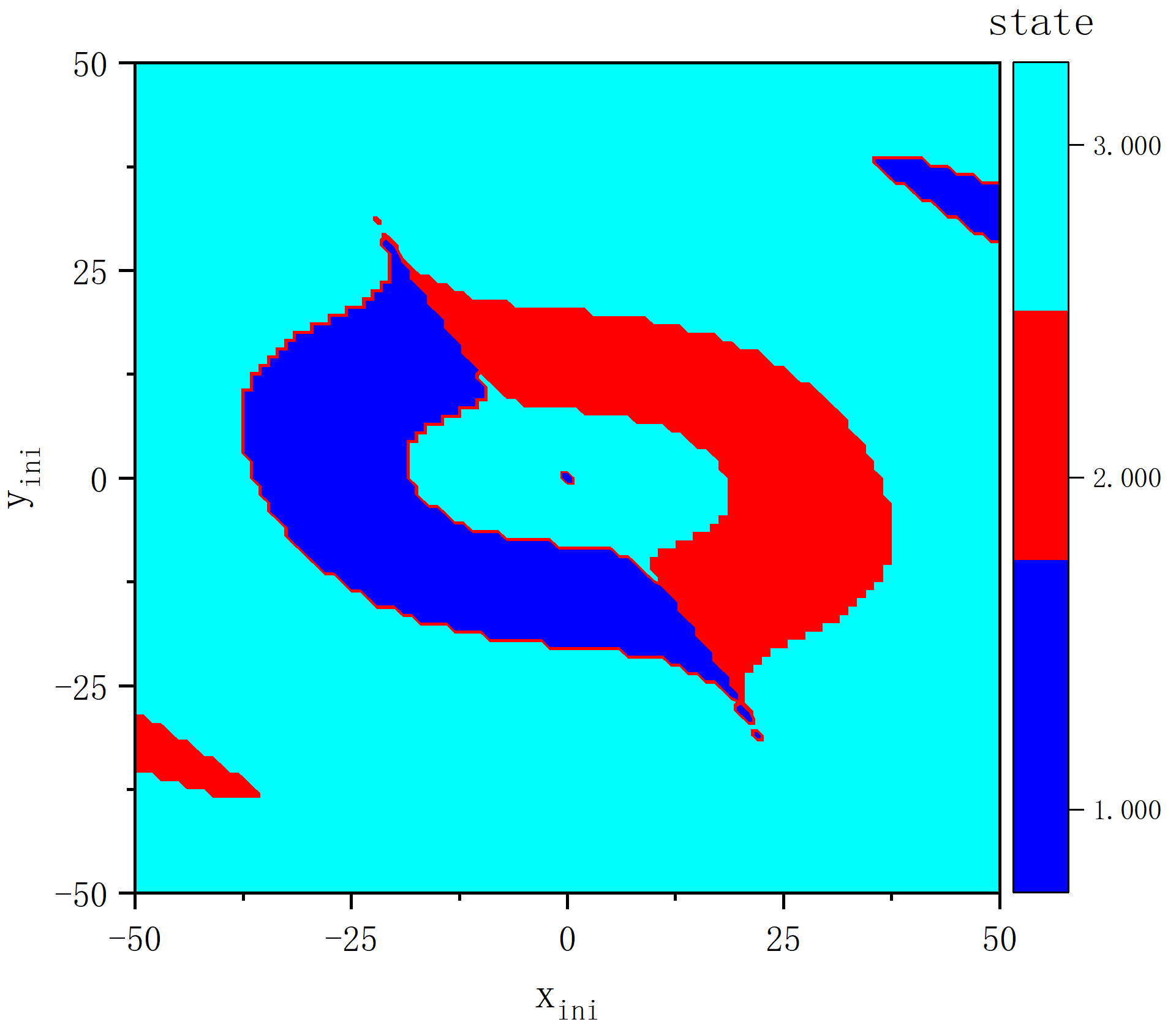
figure 7_B
module Lorenz
implicit none
real,parameter :: h=0.01
integer,parameter :: MaxT=1060000,T_trans=1050000,N=3,M=10
real :: x(M,N),f(MaxT)
integer,allocatable :: neighbour_matrix(:,:)
contains
subroutine x0(xini,yini)
implicit none
integer :: i
do i=1,M,1
x(i,1)=xini
x(i,2)=yini
x(i,3)=0.0
end do
end subroutine x0
subroutine fnf(xx,fx,i)
implicit none
real :: xx(N),fx(N),coupling
integer :: t,i,j
real :: a,b,c,K
a=10.0 !sigma
b=8.0/3.0 !beta
c=24.4 !r
coupling=0.0
K=0.05
do j=1,M,1
coupling=coupling+neighbour_matrix(i,j)*(x(j,3)-x(i,3))
end do
fx(1)=a*(xx(2)-xx(1))
fx(2)=c*xx(1)-xx(2)-xx(1)*xx(3)
fx(3)=xx(1)*xx(2)-b*xx(3)+(K/real(M-1))*coupling
return
end subroutine fnf
subroutine rk4(x,t)
implicit none
integer :: i,t
real :: x(M,N),xx(N),fx(N)
real :: kx1(N),kx2(N),kx3(N),kx4(N)
do i=1,M,1
xx=x(i,:)
call fnf(xx,fx,i,t)
kx1=h*fx
xx=x(i,:)+0.5*kx1
call fnf(xx,fx,i,t)
kx2=h*fx
xx=x(i,:)+0.5*kx2
call fnf(xx,fx,i,t)
kx3=h*fx
xx=x(i,:)+kx3
call fnf(xx,fx,i,t)
kx4=h*fx
x(i,:)=x(i,:)+(kx1+2.0*kx2+2.0*kx3+kx4)/6.0
end do
return
end subroutine rk4
!Umax与Umin
subroutine U_max_min(xxx,U_max,U_min)
implicit none
real :: U_max(M),U_min(M),xxx(M)
integer :: i
do i=1,M,1
if(U_max(i)<xxx(i)) then
U_max(i)=xxx(i)
end if
if(U_min(i)>xxx(i)) then
U_min(i)=xxx(i)
end if
end do
return
end subroutine U_max_min
!建立网络结构
subroutine neighbour()
implicit none
integer :: K !单节点K个邻居
integer :: i,j,number
allocate(neighbour_matrix(M,M))
!初始化网络矩阵
neighbour_matrix=0
do i=1,M-1,1
do j=i+1,M,1
neighbour_matrix(i,j)=1
neighbour_matrix(j,i)=1
end do
end do
!输出矩阵
do i=1,M,1
do j=1,M,1
write(10,"(I2)",advance='no') neighbour_matrix(i,j)
end do
write(10,*)
end do
return
end subroutine neighbour
!普通高斯白噪声
subroutine gaussNoise()
implicit none
integer, parameter :: L = MaxT ! 生成噪声的长度
real,parameter :: pi=3.1415926
real :: noise(L) ! 储存噪声的数组
real :: mean = 0.0 ! 均值
real :: std_dev = 1.0 ! 标准差
integer :: seed = 1 ! 随机数种子
integer :: i
open(11,file="noise.txt")
! 生成噪声
call random_seed()
do i = 1, L
call random_number(noise(i))
end do
do i=1,L-1
noise(i) = mean + std_dev * sqrt(-2.0 * log(noise(i))) * cos(2.0 * pi * noise(i + 1))
end do
noise(L)=0.0
! 输出噪声
do i = 1, L
f(i)=noise(i)
write(11,*) i,noise(i)
end do
return
end subroutine gaussNoise
!读取Rossler信号给f(t)
subroutine Rossler_f()
implicit none
integer :: i
real :: x1,x2,x3,x4
open(12,file="Rossler_t_x_y_z.txt")
do i=1,MaxT,1
read(12,*) x1,x2,x3,x4
f(i) = x2
end do
close(12)
return
end subroutine Rossler_f
!cos(a1t)+cos(a2t)
subroutine QP()
implicit none
real :: a1,a2
integer :: i
a1=1.0
a2=0.5*(1.0+sqrt(5.0))
do i=1,MaxT,1
f(i)=cos(a1*i*h)+cos(a2*i*h)
write(11,*) i,f(i)
end do
return
end subroutine QP
end module Lorenz
program main
use Lorenz
implicit none
integer :: t,i,j,jj,state
real :: U_max(M),U_min(M)
open(10,file="neighbour_matrix.txt")
open(20,file="i_t_x_B-.txt")
open(21,file="i_t_x_B+.txt")
open(22,file="i_t_x_B0.txt")
open(30,file="xmax_xmin.txt")
open(40,file="t_x_1.txt")
open(41,file="t_x_4.txt")
open(42,file="t_x_8.txt")
open(43,file="t_x_17.txt")
open(44,file="t_x_29.txt")
open(45,file="t_x_20.txt")
open(46,file="t_x_26.txt")
open(50,file="t_x_1_data.txt")
open(60,file="beta_ave_x.txt")
open(70,file="i_K_gamma_m.txt")
open(80,file="xini_yini_state.txt")
call neighbour()
!call Rossler_f()
!call QP()
!call gaussNoise()
do j=-50,50,1
do jj=-50,50,1
call x0(j,jj)
write(*,*) j,jj
U_max=-1000.0
U_min=1000.0
do t=1,MaxT,1
call rk4(x,t)
if(t>T_trans) then
call U_max_min(x(:,1),U_max,U_min)
end if
end do
do i=1,M,1
state=0
if(U_max(i)>0.0.and.U_min(i)>0.0.and.(U_max(i)-U_min(i)<2.0)) then
!正稳定点
state=1
else if(U_max(i)<0.0.and.U_min(i)<0.0.and.(U_max(i)-U_min(i)<2.0)) then
!负稳定点
state=2
else if(U_max(i)>0.0.and.U_min(i)<0.0.and.(U_max(i)-U_min(i)>10.0)) then
!奇异吸引子
state=3
end if
write(80,*) j,jj,state
end do
end do
end do
close(10)
close(20)
close(30)
close(40)
deallocate(neighbour_matrix)
end program main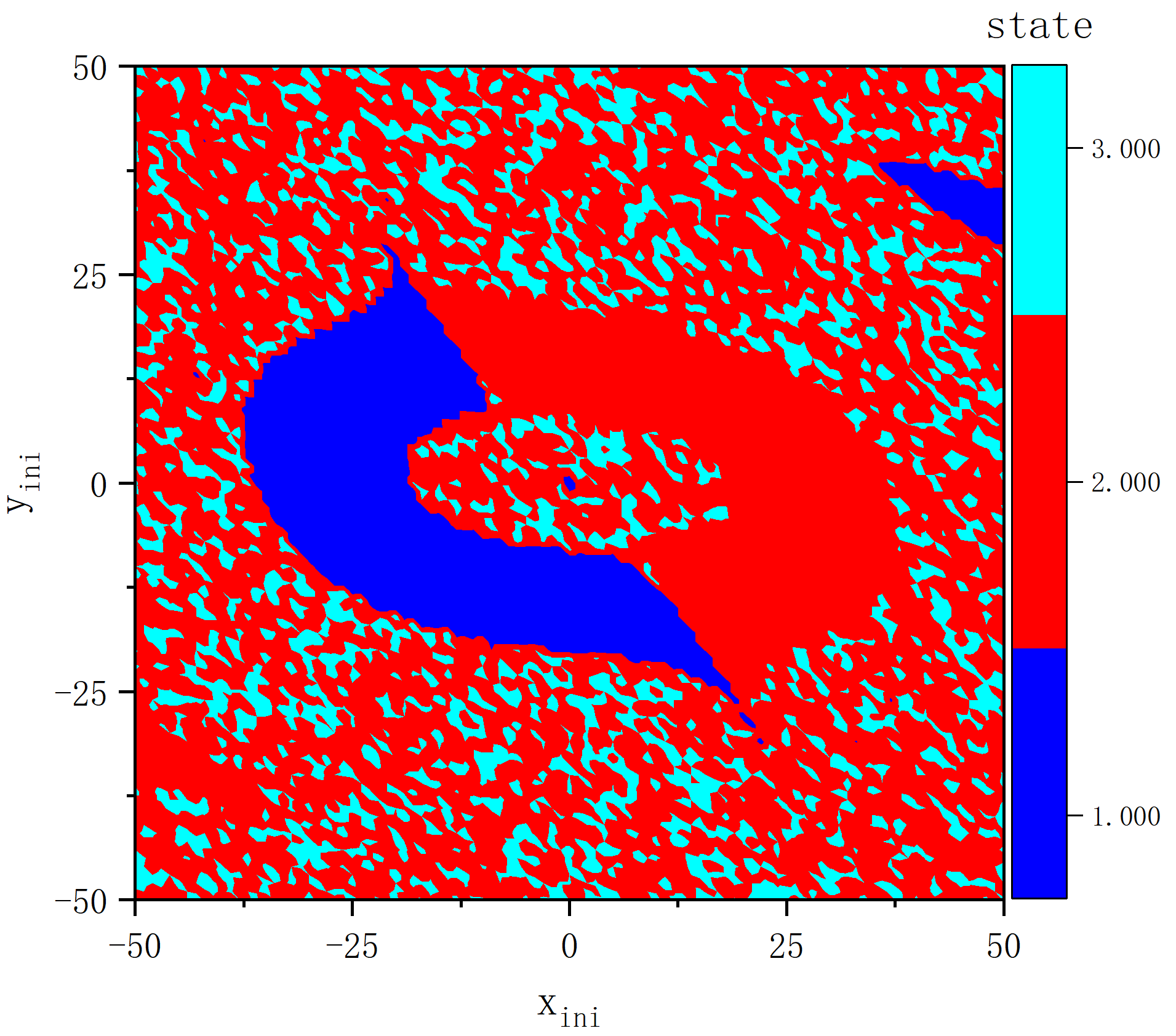
figure 8
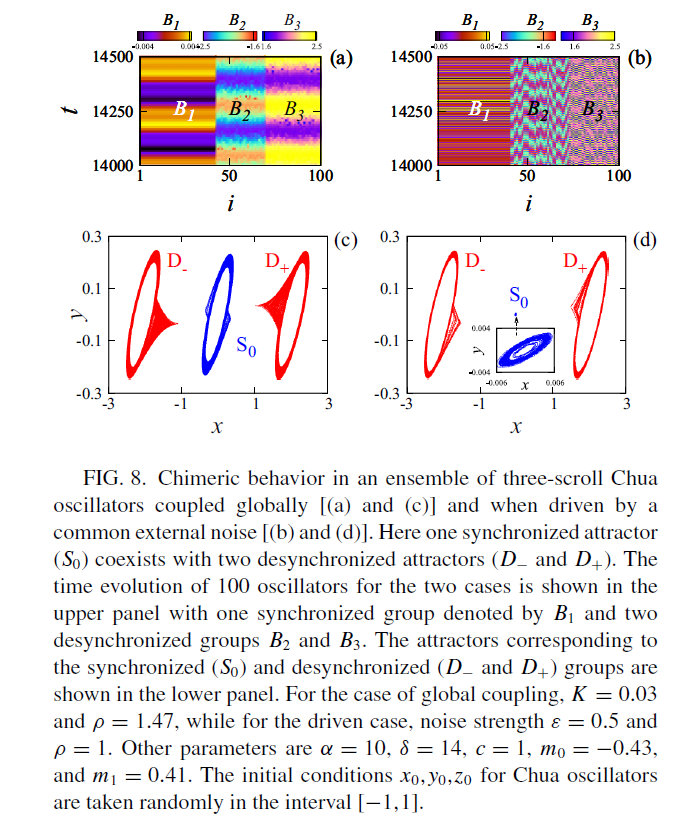
无耦合无外部调制作用(单节点)
- ρ=1.47
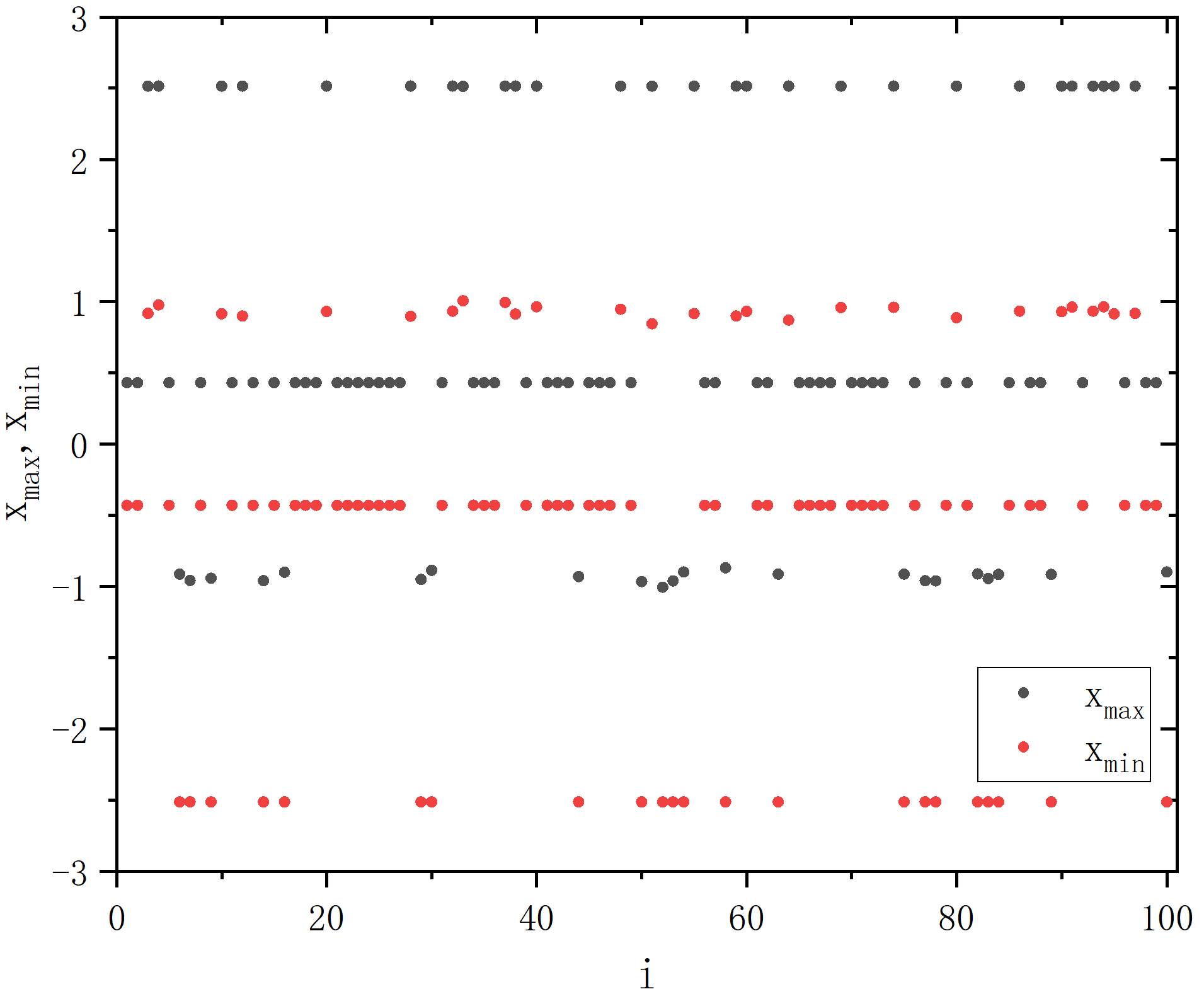
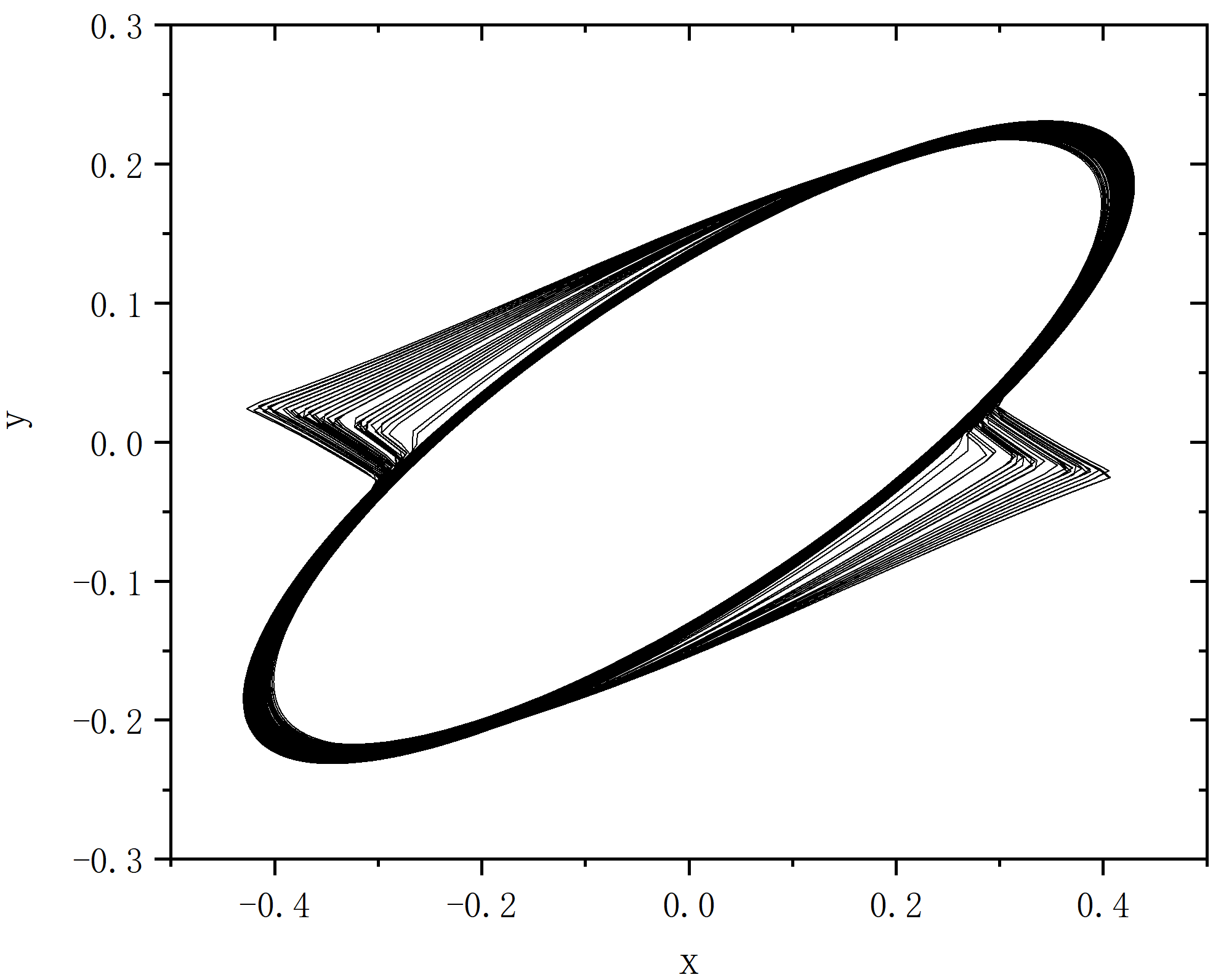
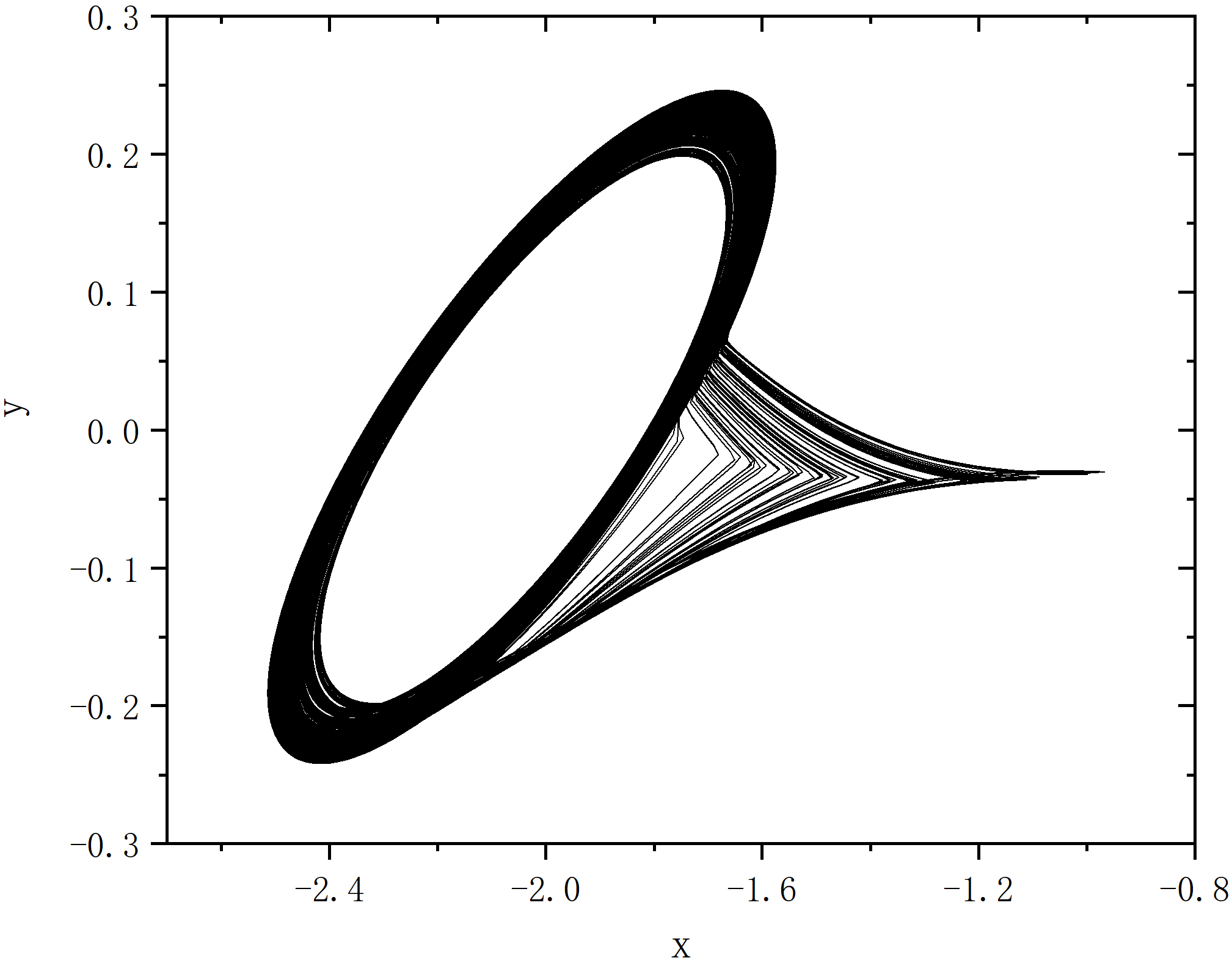
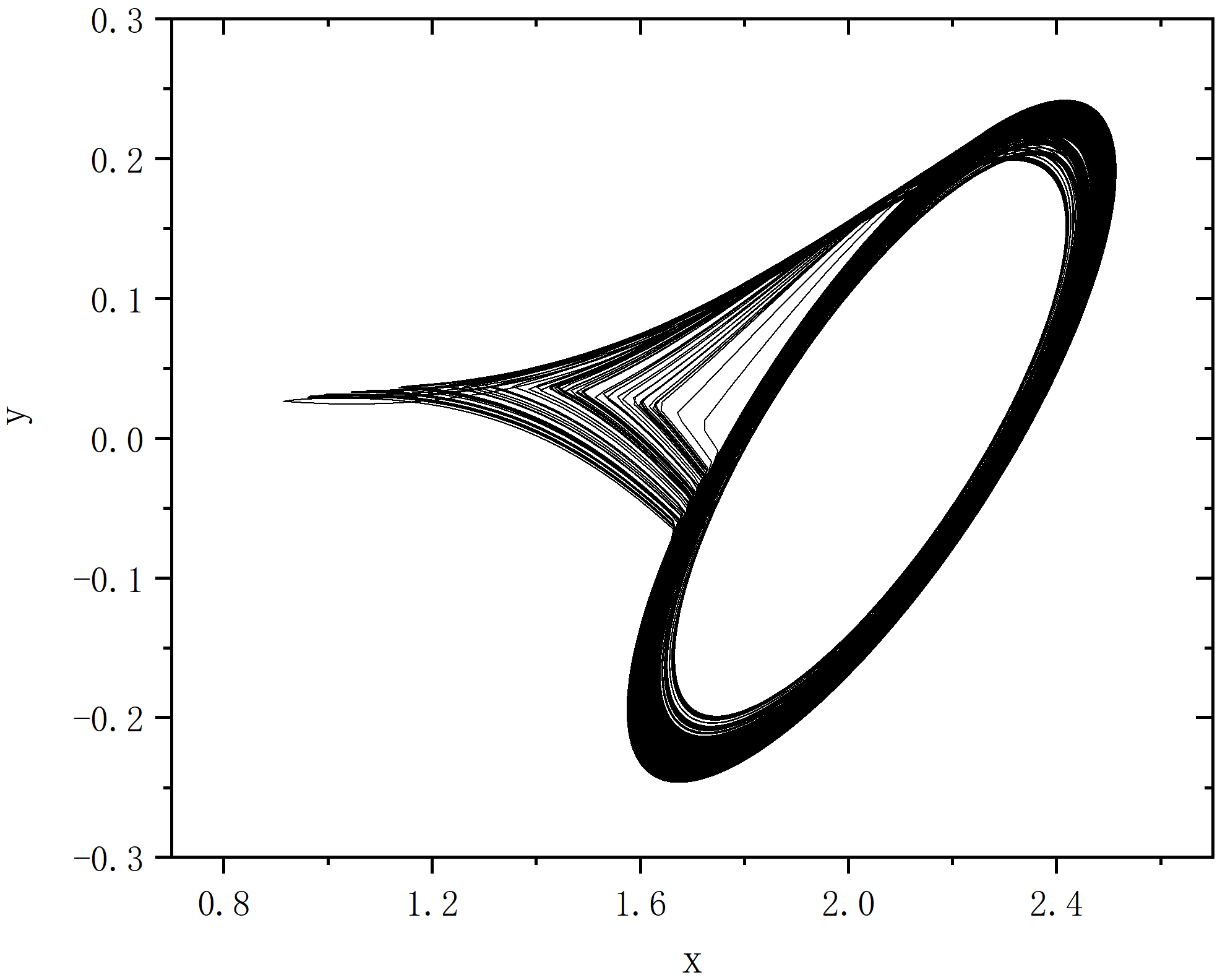
- ρ=1.5
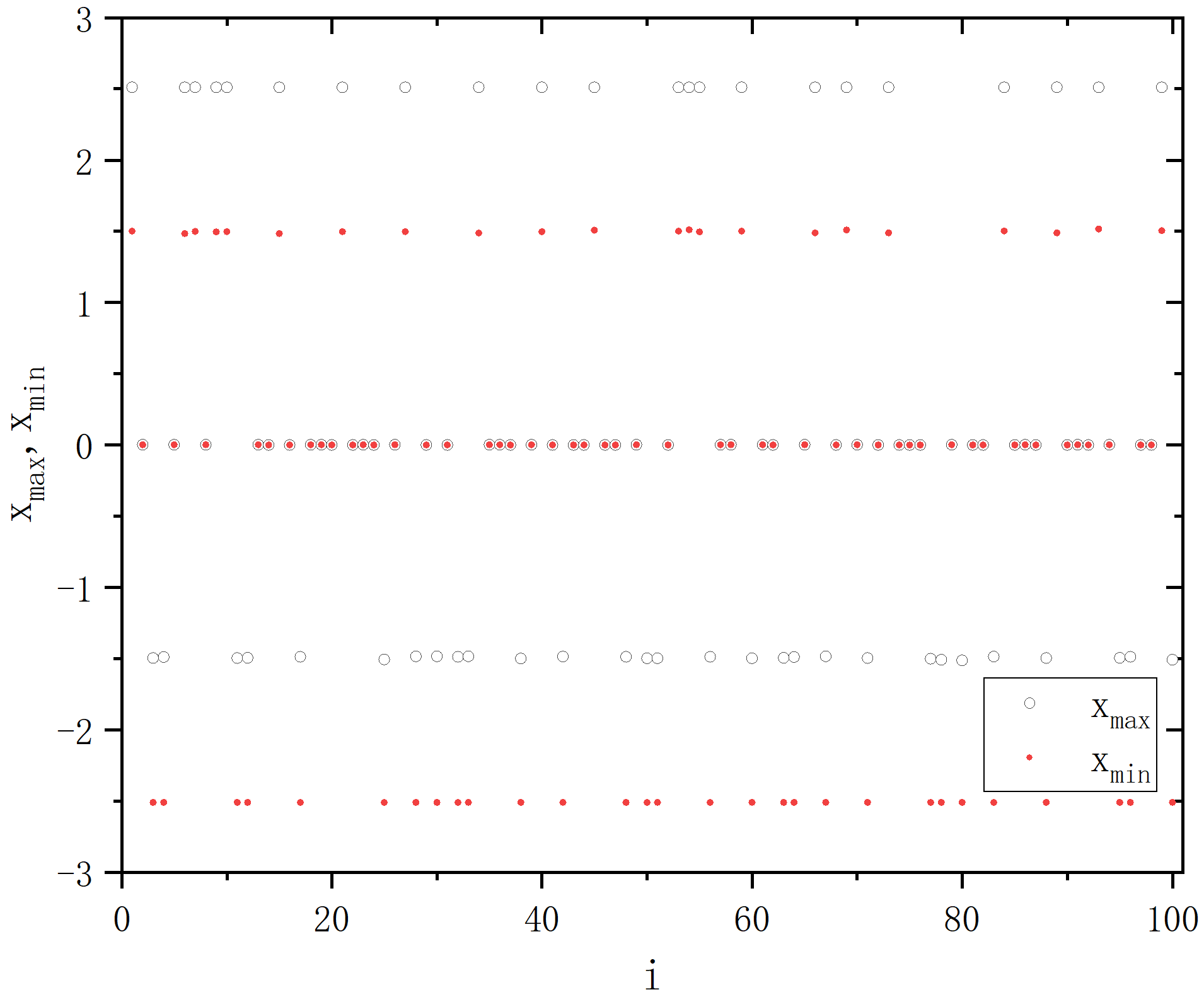
figure 8_A
module Lorenz
implicit none
real,parameter :: h=0.01
integer,parameter :: MaxT=1450000,T_trans=1400000,N=3,M=100
real :: x(M,N)
integer,allocatable :: neighbour_matrix(:,:)
contains
subroutine x0()
implicit none
integer :: i
real :: x1,x2,x3
call random_seed()
open(5,file="x0_y0_z0.txt")
do i=1,M,1
call random_number(x1)
call random_number(x2)
call random_number(x3)
x(i,1)=2*x1-1.0
x(i,2)=2*x2-1.0
x(i,3)=2*x3-1.0
write(5,*) x(i,1),x(i,2),x(i,3)
end do
close(5)
end subroutine x0
subroutine fnf(xx,fx,i)
implicit none
real :: xx(N),fx(N),coupling,gx
integer :: t,i,j
real :: a,b,c,cc,K,m0,m1
a=10.0 !alpha
b=1.47 !rho
c=14.0 !delta
K=0.03
cc=1.0
m0=-0.43
m1=0.41
coupling=0.0
do j=1,M,1
coupling=coupling+neighbour_matrix(i,j)*(x(j,2)-x(i,2))
end do
gx=m1*xx(1)+(1.0/2.0)*(m0-m1)*(abs(xx(1)+1.0)-abs(xx(1)-1.0))
if(abs(xx(3))>=cc) then
fx(1)=a*(xx(2)-gx)
else if(abs(xx(3))<cc) then
fx(1)=a*(xx(2)+gx)
end if
fx(2)=xx(1)-b*xx(2)+xx(3)+(K/real(M-1))*coupling
fx(3)=-c*xx(2)
return
end subroutine fnf
subroutine rk4(x)
implicit none
integer :: i
real :: x(M,N),xx(N),fx(N)
real :: kx1(N),kx2(N),kx3(N),kx4(N)
do i=1,M,1
xx=x(i,:)
call fnf(xx,fx,i)
kx1=h*fx
xx=x(i,:)+0.5*kx1
call fnf(xx,fx,i)
kx2=h*fx
xx=x(i,:)+0.5*kx2
call fnf(xx,fx,i)
kx3=h*fx
xx=x(i,:)+kx3
call fnf(xx,fx,i)
kx4=h*fx
x(i,:)=x(i,:)+(kx1+2.0*kx2+2.0*kx3+kx4)/6.0
end do
return
end subroutine rk4
!Umax与Umin
subroutine U_max_min(xxx,U_max,U_min)
implicit none
real :: U_max(M),U_min(M),xxx(M)
integer :: i
do i=1,M,1
if(U_max(i)<xxx(i)) then
U_max(i)=xxx(i)
end if
if(U_min(i)>xxx(i)) then
U_min(i)=xxx(i)
end if
end do
return
end subroutine U_max_min
!建立网络结构
subroutine neighbour()
implicit none
integer :: i,j,number
allocate(neighbour_matrix(M,M))
!初始化网络矩阵
neighbour_matrix=0
do i=1,M-1,1
do j=i+1,M,1
neighbour_matrix(i,j)=1
neighbour_matrix(j,i)=1
end do
end do
!输出矩阵
do i=1,M,1
do j=1,M,1
write(10,"(I2)",advance='no') neighbour_matrix(i,j)
end do
write(10,*)
end do
return
end subroutine neighbour
end module Lorenz
program main
use Lorenz
implicit none
integer :: t,i,j,counter
real :: U_max(M),U_min(M),data(M,MaxT-T_trans,3)
open(10,file="neighbour_matrix.txt")
open(20,file="i_t_x_B-.txt")
open(21,file="i_t_x_B+.txt")
open(22,file="i_t_x_B0.txt")
open(30,file="xmax_xmin.txt")
open(40,file="t_x_1.txt")
open(41,file="t_x_5.txt")
open(42,file="t_x_50.txt")
open(43,file="t_x_23.txt")
open(44,file="t_x_95.txt")
open(45,file="t_x_36.txt")
open(46,file="t_x_61.txt")
open(50,file="t_x_1_data.txt")
open(60,file="error.txt")
call neighbour()
call x0
U_max=-1000.0
U_min=1000.0
counter=1
do t=1,MaxT,1
call rk4(x)
if(t>T_trans) then
call U_max_min(x(:,1),U_max,U_min)
write(40,*) (t-T_trans)*h,x(1,1),x(1,2),x(1,3)
write(41,*) (t-T_trans)*h,x(5,1),x(5,2),x(5,3)
write(42,*) (t-T_trans)*h,x(50,1),x(50,2),x(50,3)
write(43,*) (t-T_trans)*h,x(23,1),x(23,2),x(23,3)
write(44,*) (t-T_trans)*h,x(95,1),x(95,2),x(95,3)
write(45,*) (t-T_trans)*h,x(36,1),x(36,2),x(36,3)
write(46,*) (t-T_trans)*h,x(61,1),x(61,2),x(61,3)
!将相同的动力学模式放在一起
do i=1,M,1
data(i,t-T_trans,1) = x(i,1)
data(i,t-T_trans,2) = x(i,2)
data(i,t-T_trans,3) = x(i,3)
end do
end if
end do
do i=1,M,1
write(30,*) i,U_max(i),U_min(i)
do t=1,MaxT-T_trans,1
if(U_max(i)>0.0.and.U_min(i)<0.0) then
!B1
if(mod(t,100)==0) then
write(20,*) i,t,data(i,t,1),data(i,t,2),data(i,t,3)
end if
else if(U_max(i)<0.0.and.U_min(i)<0.0) then
!B2
if(mod(t,100)==0) then
write(21,*) i,t,data(i,t,1),data(i,t,2),data(i,t,3)
end if
else if(U_max(i)>0.0.and.U_min(i)>0.0) then
!B3
if(mod(t,100)==0) then
write(22,*) i,t,data(i,t,1),data(i,t,2),data(i,t,3)
end if
else
write(60,*) "条件有误!"
end if
end do
end do
close(10)
close(20)
close(30)
close(40)
deallocate(neighbour_matrix)
end program main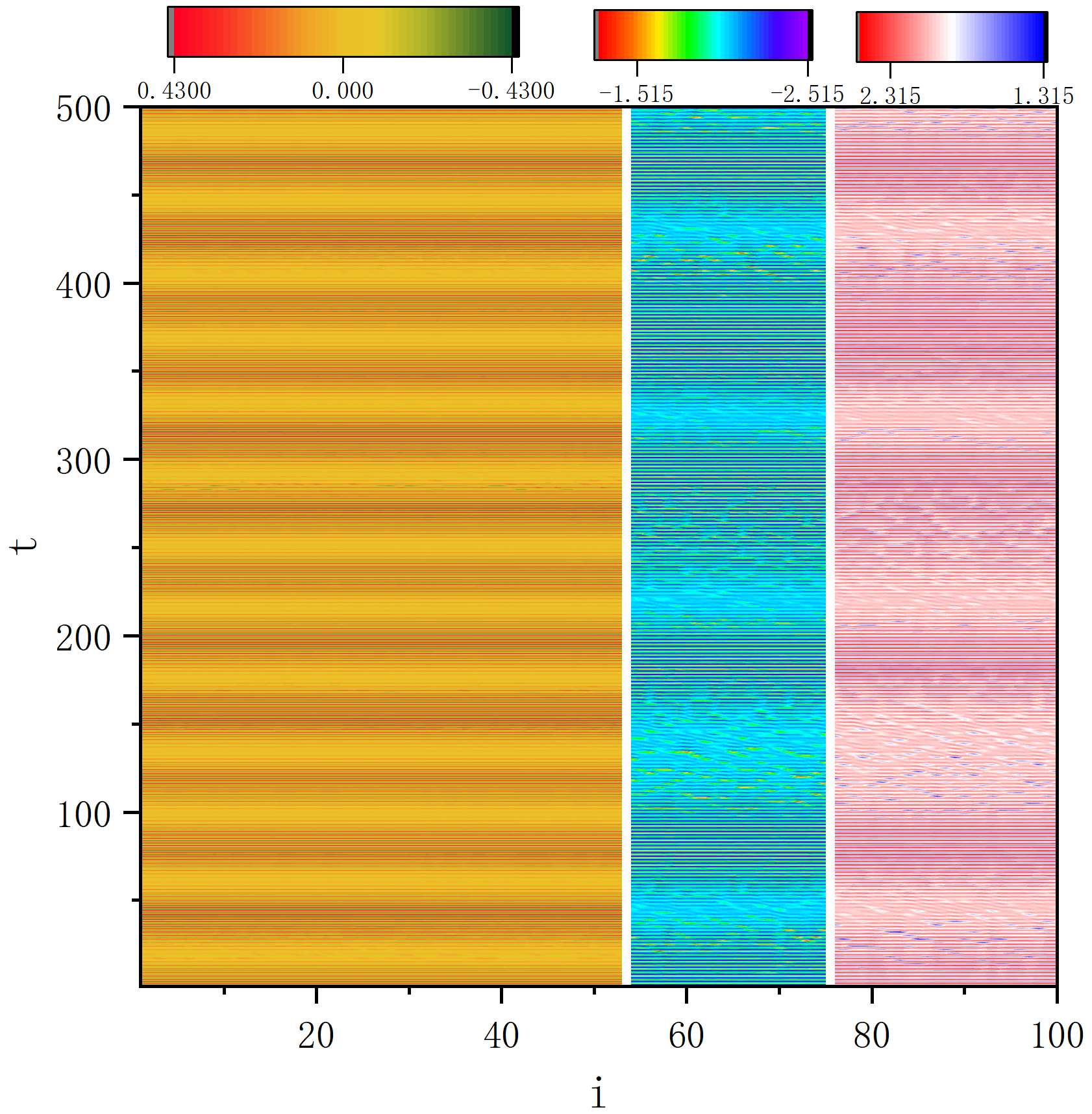
figure 8_B
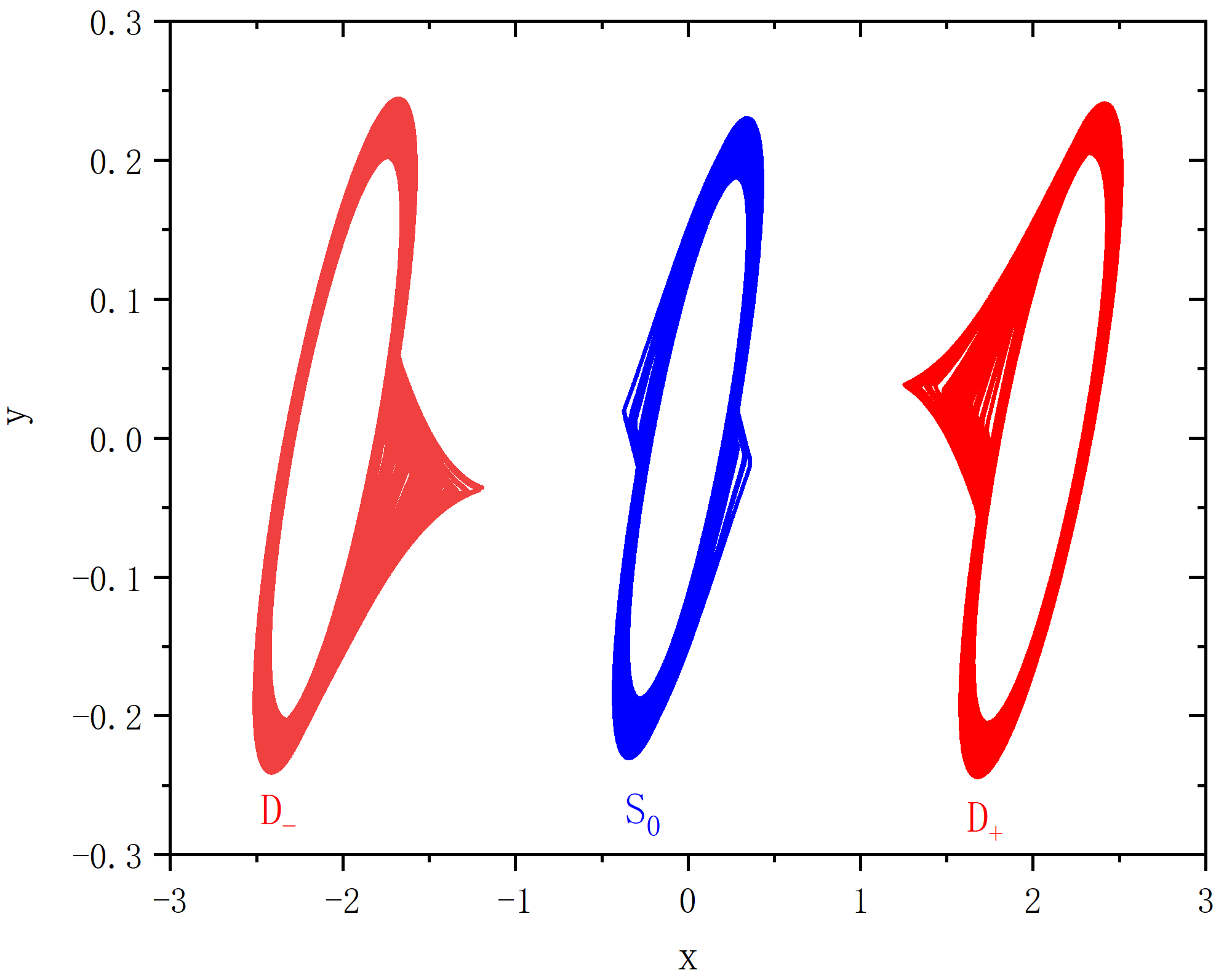
figure 8_C
module Lorenz
implicit none
real,parameter :: h=0.01
integer,parameter :: MaxT=1950000,T_trans=1900000,N=3,M=100
real :: x(M,N),f(MaxT)
integer,allocatable :: neighbour_matrix(:,:)
contains
subroutine x0()
implicit none
integer :: i
real :: x1,x2,x3
call random_seed()
open(5,file="x0_y0_z0.txt")
do i=1,M,1
call random_number(x1)
call random_number(x2)
call random_number(x3)
x(i,1)=2*x1-1.0
x(i,2)=2*x2-1.0
x(i,3)=2*x3-1.0
write(5,*) x(i,1),x(i,2),x(i,3)
end do
close(5)
end subroutine x0
subroutine fnf(xx,fx,i,t)
implicit none
real :: xx(N),fx(N),coupling,gx
integer :: t,i,j
real :: a,b,c,cc,m0,m1,epsilon
a=10.0 !alpha
b=1.50 !rho
c=14.0 !delta
cc=1.0
m0=-0.43
m1=0.41
epsilon=0.5
gx=m1*xx(1)+(1.0/2.0)*(m0-m1)*(abs(xx(1)+1.0)-abs(xx(1)-1.0))
if(abs(xx(3))>cc) then
fx(1)=a*(xx(2)-gx)
else if(abs(xx(3))<=cc) then
fx(1)=a*(xx(2)+gx)
end if
fx(2)=xx(1)-b*xx(2)+xx(3)+epsilon*f(t)
fx(3)=-c*xx(2)
return
end subroutine fnf
subroutine rk4(x,t)
implicit none
integer :: i,t
real :: x(M,N),xx(N),fx(N)
real :: kx1(N),kx2(N),kx3(N),kx4(N)
do i=1,M,1
xx=x(i,:)
call fnf(xx,fx,i,t)
kx1=h*fx
xx=x(i,:)+0.5*kx1
call fnf(xx,fx,i,t)
kx2=h*fx
xx=x(i,:)+0.5*kx2
call fnf(xx,fx,i,t)
kx3=h*fx
xx=x(i,:)+kx3
call fnf(xx,fx,i,t)
kx4=h*fx
x(i,:)=x(i,:)+(kx1+2.0*kx2+2.0*kx3+kx4)/6.0
end do
return
end subroutine rk4
!Umax与Umin
subroutine U_max_min(xxx,U_max,U_min)
implicit none
real :: U_max(M),U_min(M),xxx(M)
integer :: i
do i=1,M,1
if(U_max(i)<xxx(i)) then
U_max(i)=xxx(i)
end if
if(U_min(i)>xxx(i)) then
U_min(i)=xxx(i)
end if
end do
return
end subroutine U_max_min
!建立网络结构
subroutine neighbour()
implicit none
integer :: i,j,number
allocate(neighbour_matrix(M,M))
!初始化网络矩阵
neighbour_matrix=0
do i=1,M-1,1
do j=i+1,M,1
neighbour_matrix(i,j)=1
neighbour_matrix(j,i)=1
end do
end do
!输出矩阵
do i=1,M,1
do j=1,M,1
write(10,"(I2)",advance='no') neighbour_matrix(i,j)
end do
write(10,*)
end do
return
end subroutine neighbour
!普通高斯白噪声
subroutine gaussNoise()
implicit none
integer, parameter :: L = MaxT ! 生成噪声的长度
real,parameter :: pi=3.1415926
real :: noise(L) ! 储存噪声的数组
real :: mean = 0.0 ! 均值
real :: std_dev = 0.01 ! 标准差
integer :: seed = 1 ! 随机数种子
integer :: i
open(11,file="noise.txt")
! 生成噪声
call random_seed()
do i = 1, L
call random_number(noise(i))
end do
do i=1,L-1
noise(i) = mean + std_dev * sqrt(-2.0 * log(noise(i))) * cos(2.0 * pi * noise(i + 1))
end do
noise(L)=0.0
! 输出噪声
do i = 1, L
f(i)=noise(i)
!write(11,*) i,noise(i)
end do
return
end subroutine gaussNoise
end module Lorenz
program main
use Lorenz
implicit none
integer :: t,i,j,counter
real :: U_max(M),U_min(M),data(M,MaxT-T_trans,3)
open(10,file="neighbour_matrix.txt")
open(20,file="i_t_x_B-.txt")
open(21,file="i_t_x_B+.txt")
open(22,file="i_t_x_B0.txt")
open(30,file="xmax_xmin.txt")
open(40,file="t_x_1.txt")
open(41,file="t_x_5.txt")
open(42,file="t_x_50.txt")
open(43,file="t_x_23.txt")
open(44,file="t_x_95.txt")
open(45,file="t_x_36.txt")
open(46,file="t_x_61.txt")
open(50,file="t_x_1_data.txt")
open(60,file="error.txt")
call neighbour()
call x0
call gaussNoise()
U_max=-1000.0
U_min=1000.0
counter=1
do t=1,MaxT,1
call rk4(x,t)
if(t>T_trans) then
call U_max_min(x(:,1),U_max,U_min)
write(40,*) (t-T_trans)*h,x(1,1),x(1,2),x(1,3)
write(41,*) (t-T_trans)*h,x(5,1),x(5,2),x(5,3)
write(42,*) (t-T_trans)*h,x(50,1),x(50,2),x(50,3)
write(43,*) (t-T_trans)*h,x(23,1),x(23,2),x(23,3)
write(44,*) (t-T_trans)*h,x(95,1),x(95,2),x(95,3)
write(45,*) (t-T_trans)*h,x(36,1),x(36,2),x(36,3)
write(46,*) (t-T_trans)*h,x(61,1),x(61,2),x(61,3)
!将相同的动力学模式放在一起
do i=1,M,1
data(i,t-T_trans,1) = x(i,1)
data(i,t-T_trans,2) = x(i,2)
data(i,t-T_trans,3) = x(i,3)
end do
end if
end do
do i=1,M,1
write(30,*) i,U_max(i),U_min(i)
do t=1,MaxT-T_trans,1
if(U_max(i)>0.0.and.U_min(i)<0.0) then
!B1
if(mod(t,100)==0) then
write(20,*) i,t,data(i,t,1),data(i,t,2),data(i,t,3)
end if
else if(U_max(i)<0.0.and.U_min(i)<0.0) then
!B2
if(mod(t,100)==0) then
write(21,*) i,t,data(i,t,1),data(i,t,2),data(i,t,3)
end if
else if(U_max(i)>0.0.and.U_min(i)>0.0) then
!B3
if(mod(t,100)==0) then
write(22,*) i,t,data(i,t,1),data(i,t,2),data(i,t,3)
end if
else
write(60,*) "条件有误!"
end if
end do
end do
close(10)
close(20)
close(30)
close(40)
deallocate(neighbour_matrix)
end program main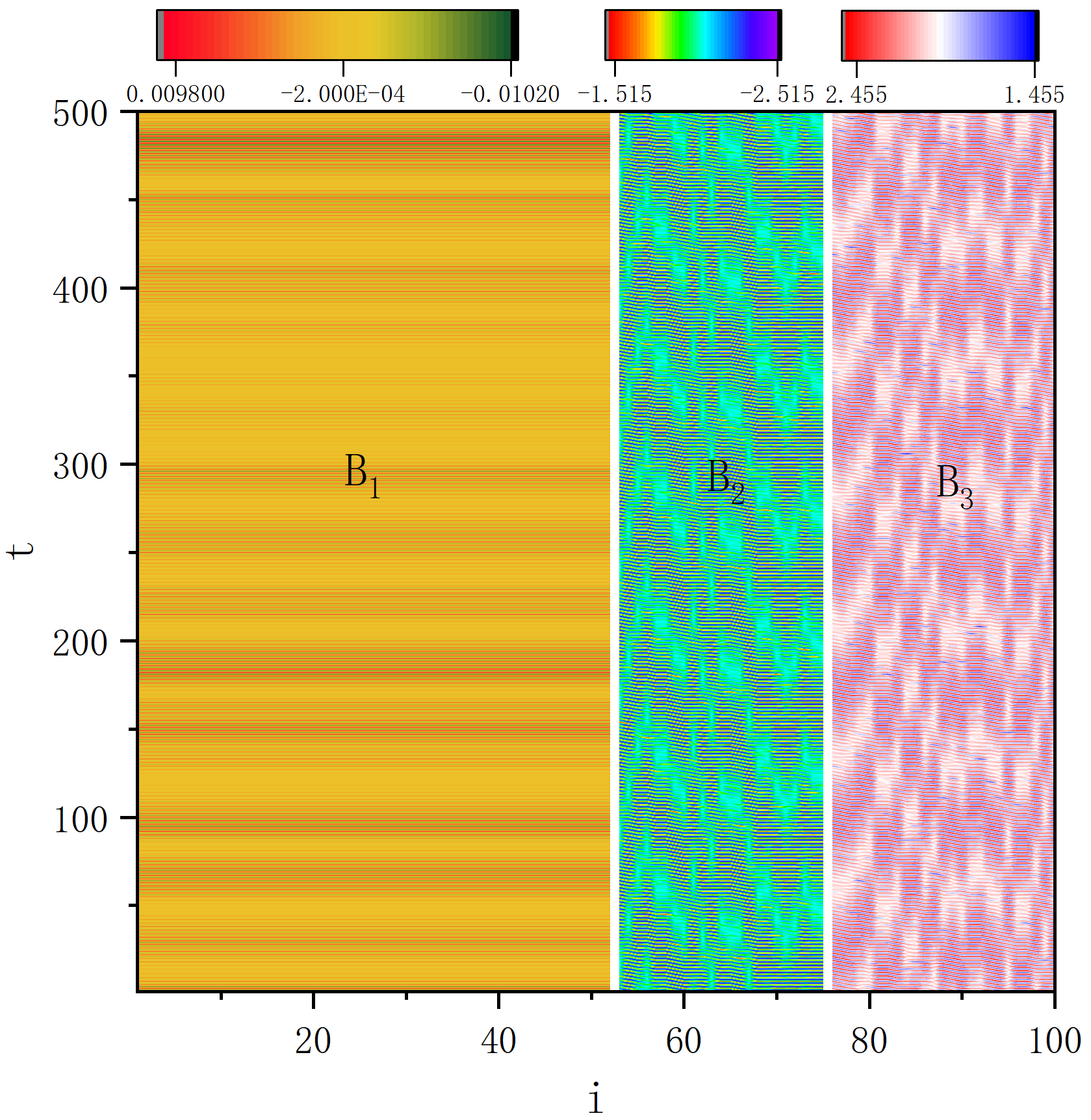
figure 8_D
